

EMI Cassette Tapes
Original Album Series
#03. Let It Be (TC-PCS 7096)
(Update: 8th. March 2025)




| New Records from EMI (August 1970) |
||||
| SHEET: FRONT | Musicassette pages |
EMI Original
Promotional dealer leaflet. This promotional leaflet would detail the forthcoming September 1970 Records, Musicassettes, Reel to Reel, and 8-track cartridges releases. It says that cassette tapes, 8-track cartridge, and reel to reel of "Let It Be" will be released at the same time on this August. |
||
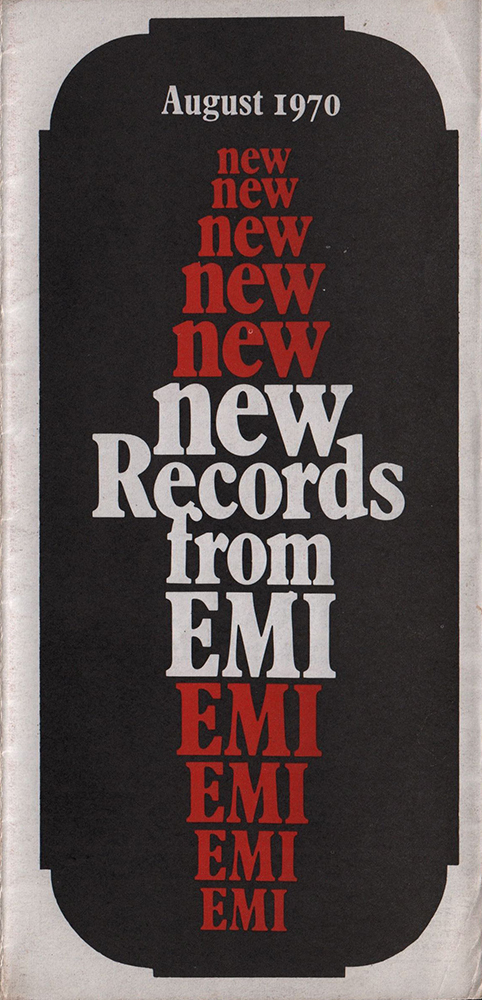 |
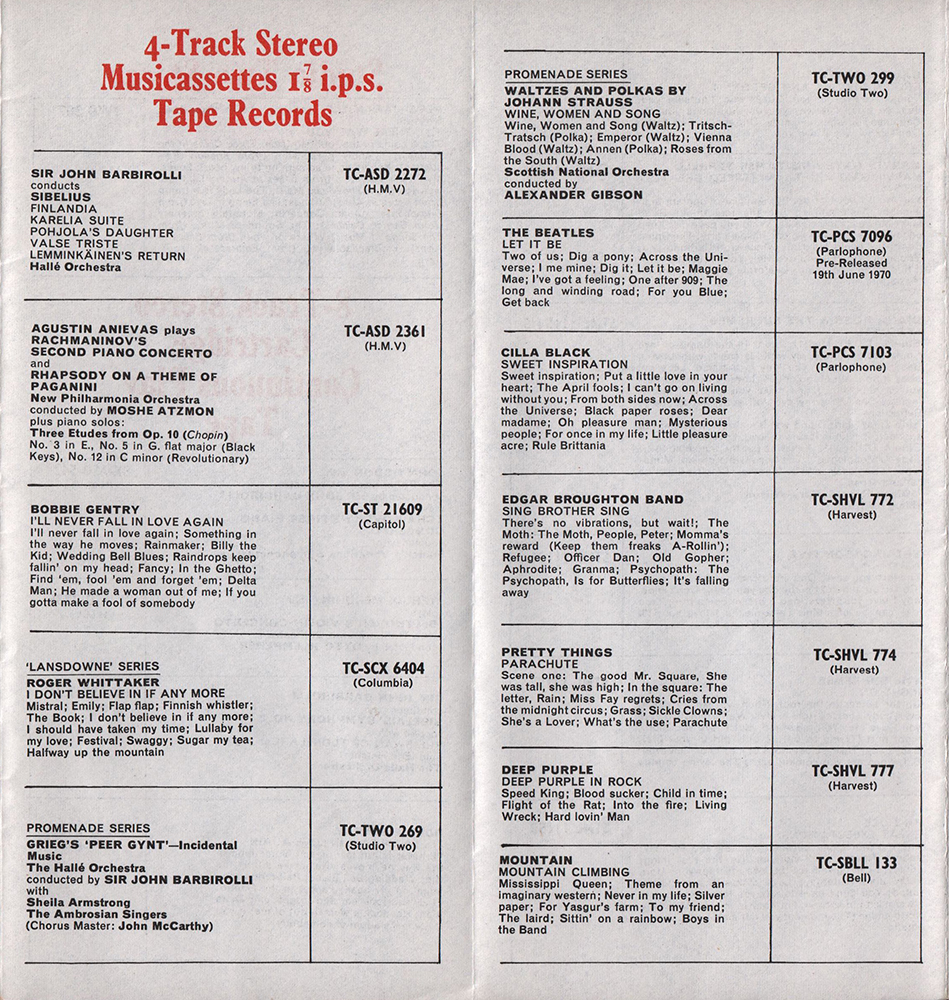 |
|||
| SHEET: BACK |
8-Track Information:
CLOSE UP |
Cassette Tape
Information: CLOSE UP |
||
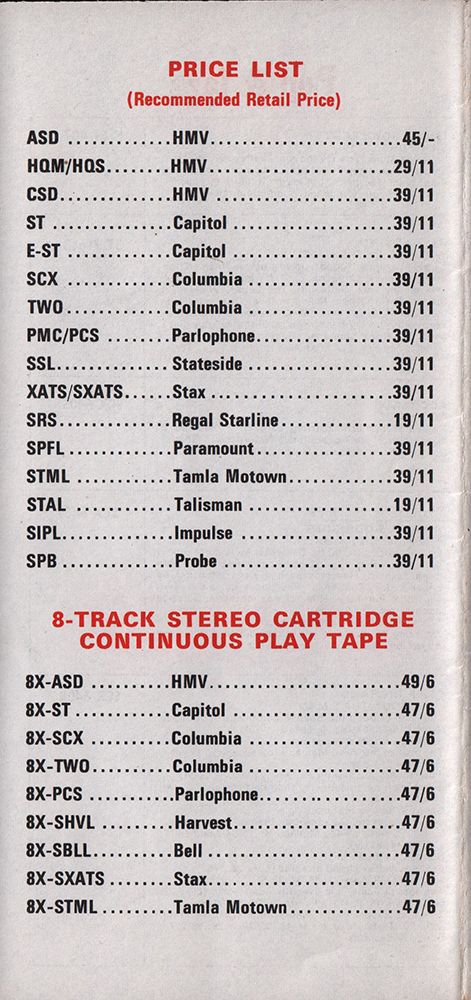 |
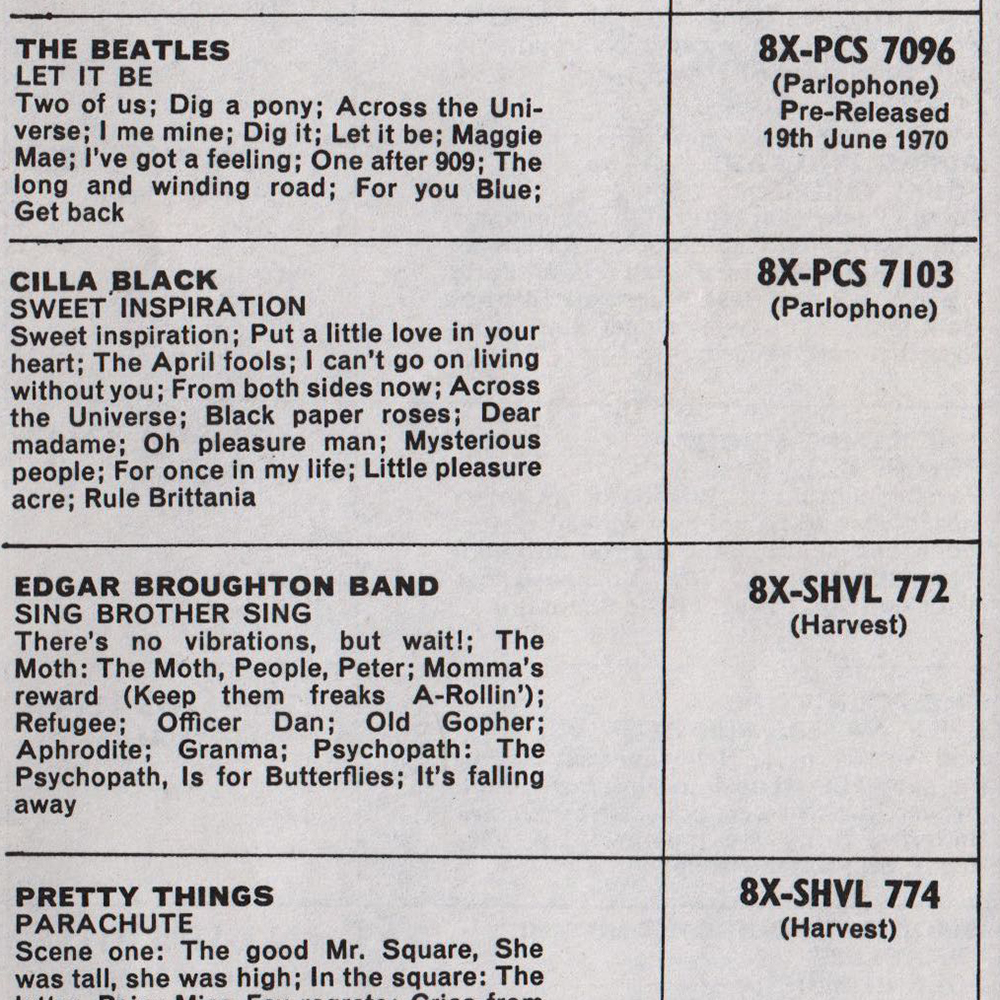 |
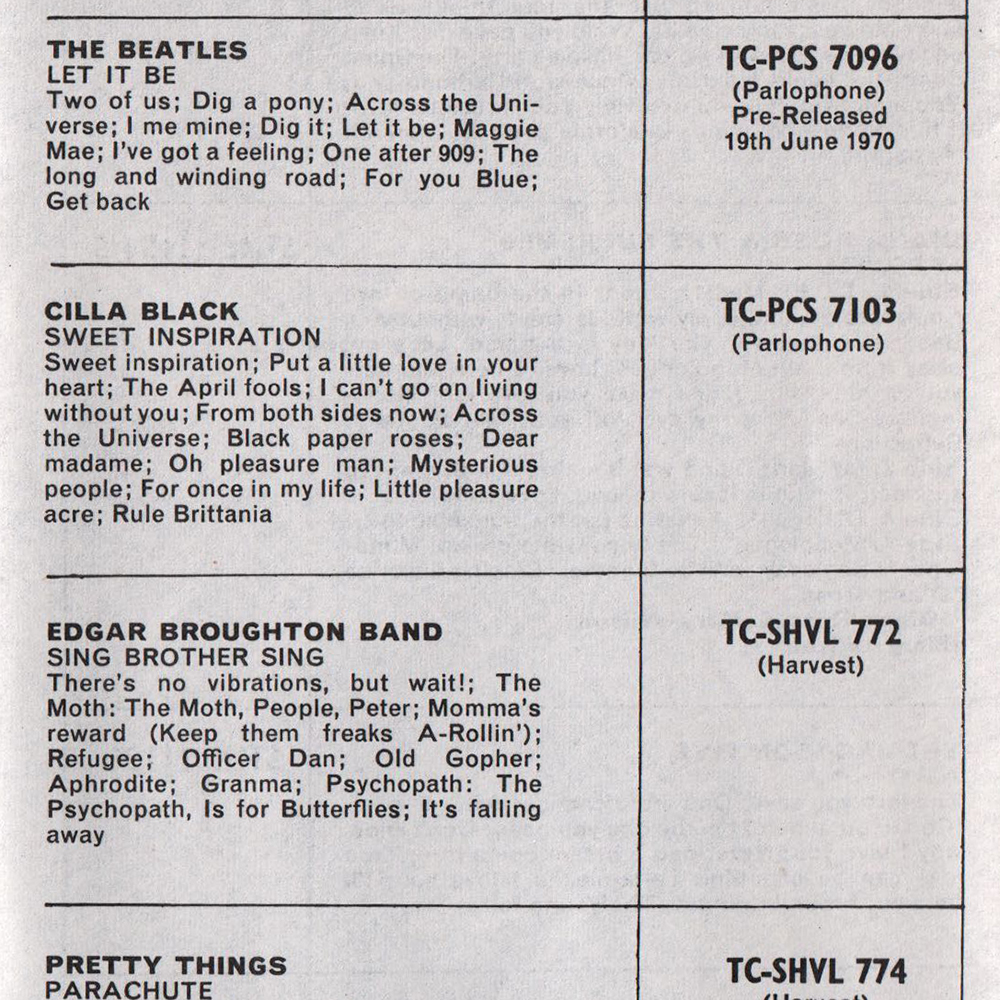 |
||
|
TITLE
|
LET IT BE |
|||
| CATALOG NUMBER | TC-PCS 7096 / 1E 262 o 04482 |
|||
|
RELEASE DATE
|
August 1970 / First Issue | |||
| TRACK LISTING | SIDE 1 | SIDE 2 | ||
| Two Of Us [A1] |
Maggie Mae [A7] |
|||
| I Me Mine [A4] | Dig A Pony [A2] |
|||
| One After 909 [B2] |
The Long And Winding Road [B3] |
|||
| Across The Universe [A3] |
I Got A Feeling [B1] |
|||
| Dig It [A5] |
For You Blue [B4] |
|||
| Let It Be [A6] | Get Back [B5] | |||
| CASSETTE CASE AND TAPE |
CASE FRONT | CASE BACK | SIDE 1 --> Click! | SIDE 2 --> Click! |
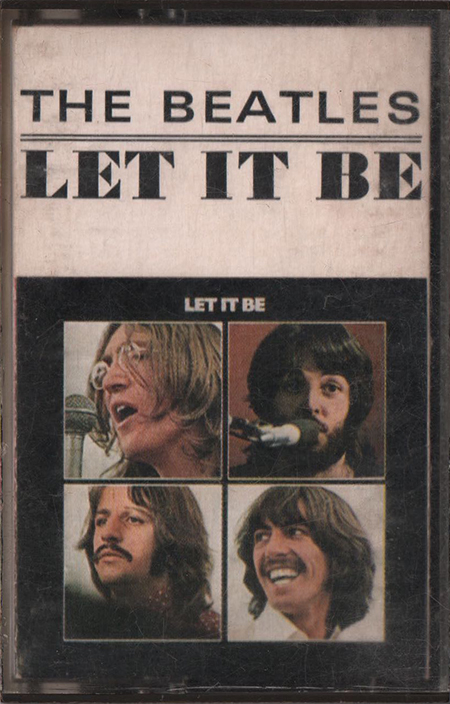 |
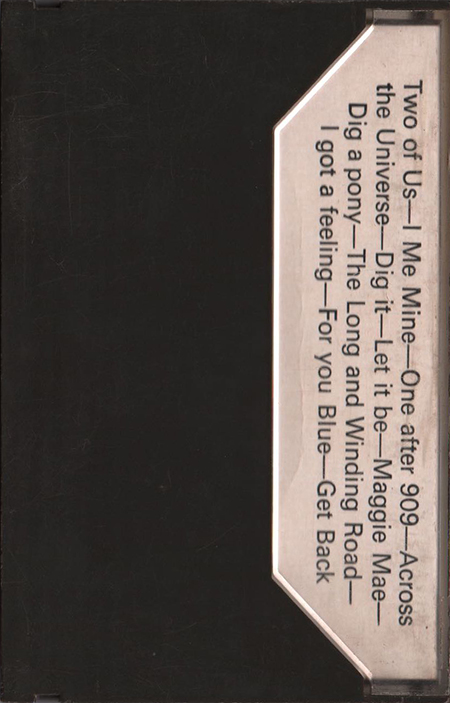 |
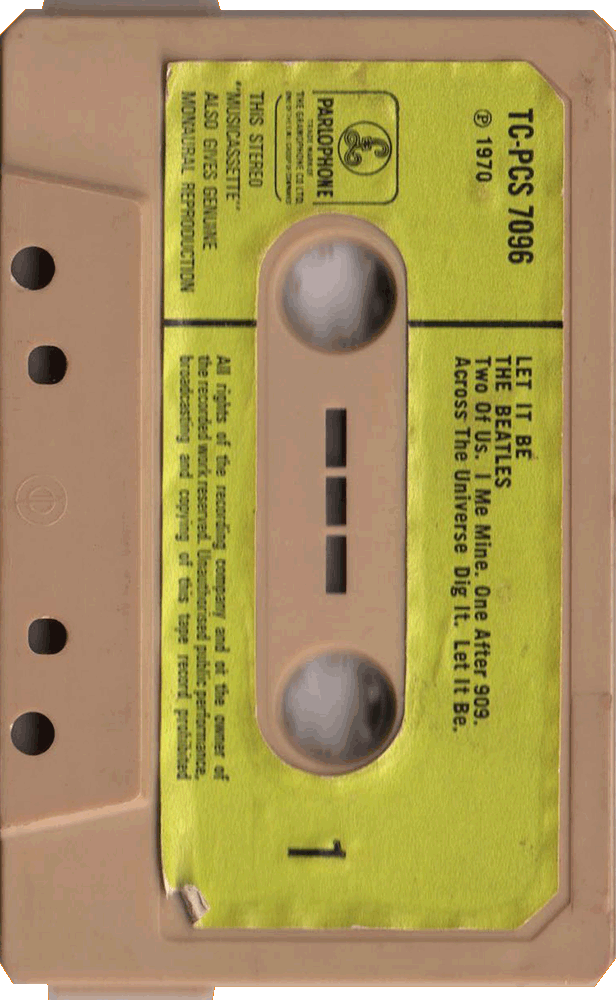 |
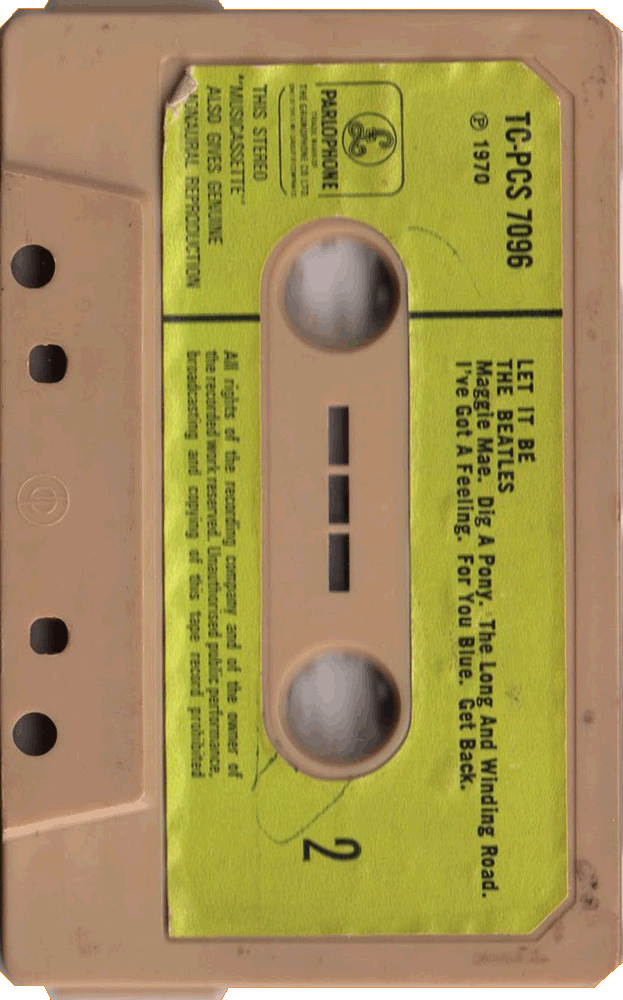 |
|
| The cassette cases ("Norelco" cases)
were clear plastic at the front and around the spine area,
and black plastic at the rear. |
The first UK issue of "Let It Be" has Lemon Yellow
paper label with Parlophone logo. Has the 3 windows shell. |
|||
| INLAY |
INLAY: FRONT | INLAY: INSIDE |
||
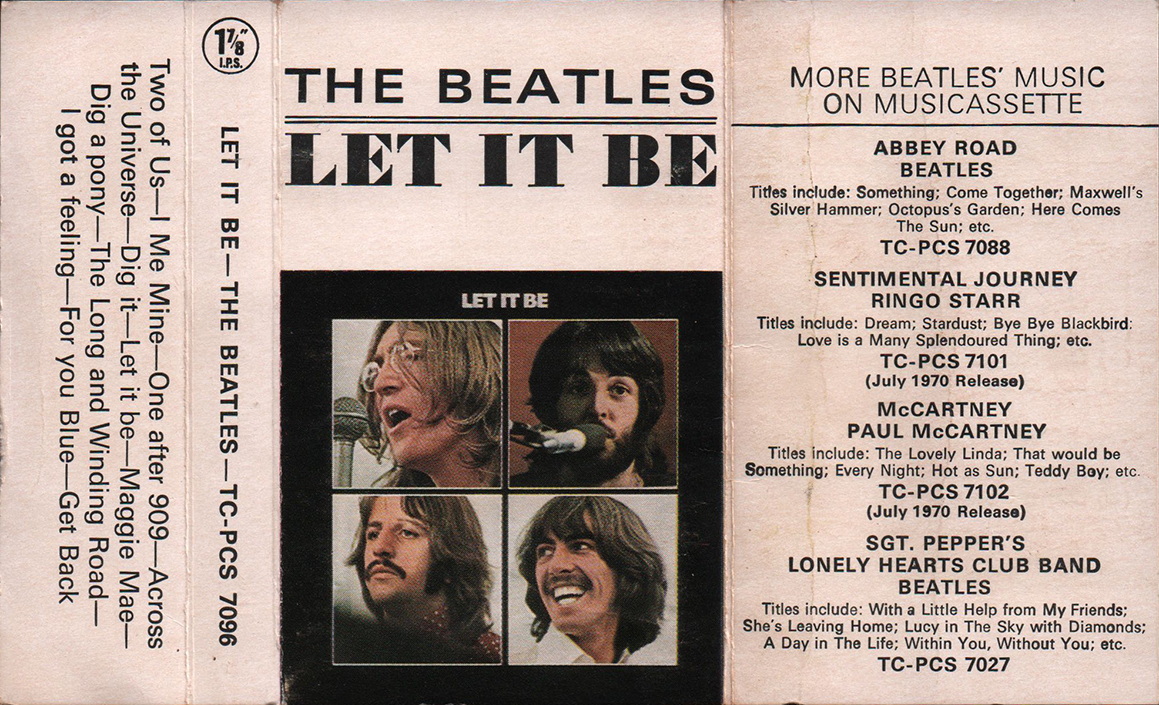 |
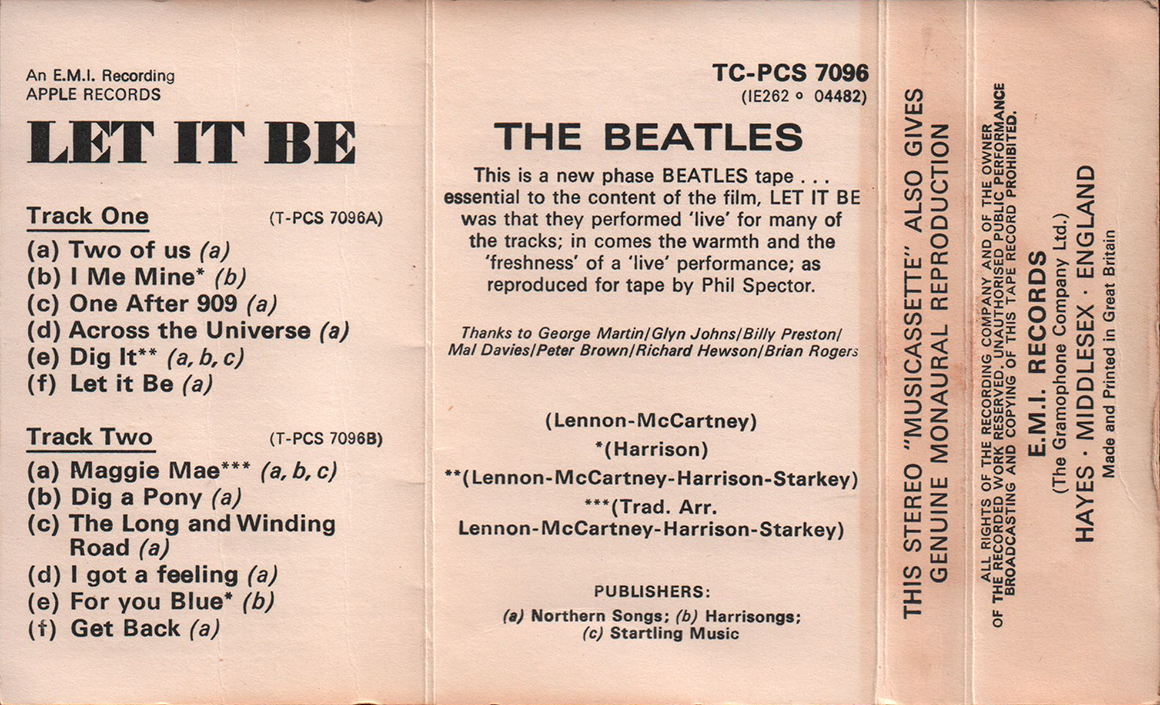 |
|||
| The 1970/71 cassettes had white inlays
and, aside from the small reproduction of the front cover,
no artwork was included nor the original liner notes. The
tracklistings were printed on the reverse of the inlay
whilst the foldovers advertised other available Beatles/solo
cassettes. |
||||
| INLAY: FRONT CLOSE UP | ||||
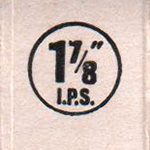 |
The
circular 1 7/8 " I.P.S. mark was printed at the spine. As the standard tape speed for a compact cassette is 1 ⅞ ips (1.875 inches per second). |
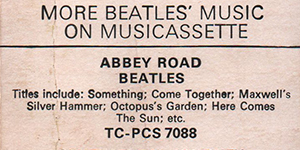 |
The tracklistings were
printed on the reverse of the inlay whilst the foldovers
advertised other available Beatles cassettes. |
|
| INLAY: FRONT CLOSE UP | ||||
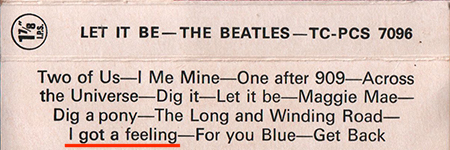 |
EMI
originally issued the Beatles UK albums on cassette tape
with re-arranged running orders, the reason for this was
that because of the 8-track stereo tapes made at the same
time, it was necessary to adjust the endless tape's four
tracks to be approximately the same length. Inlay incorrectly spells track 4 on side-2 as "I got a feeling". |
|||
| INLAY: INSIDE CLOSE UP | ||||
 |
"Apple Records" credit was printed on the
inlay. |
 |
Catalog number "TC-PCS 7096" and the EMI country code (*1) were printed on the inlay. | |
| INLAY: INSIDE CLOSE UP | ||||
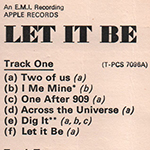 |
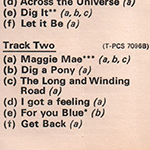 |
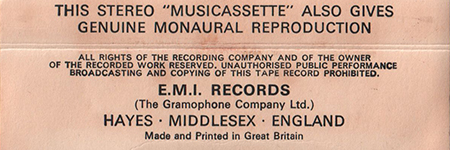 |
||
| The tracklistings were printed on the reverse of
the inlay. EMI originally issued the Beatles UK albums on
cassette tape with re-arranged running orders. |
"E.M.I. Records (The Gramophone Company Ltd.)" credit was printed at the bottom of the inside of the inlay. | |||
| LABEL CLOSE UP | ||||
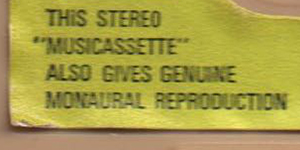 |
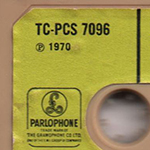 |
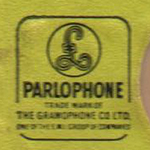 |
The 1st. cassette was
issued with £ Parlophone logo. NO "IE"
catalogue number in addition to the ordinary "TC-PCS 7096"
EMI catalogue number. |
|
| LABEL CLOSE UP | ||||
| SIDE
1 |
SIDE 2 |
The
tracklistings were printed on the reverse of the inlay. EMI
originally issued the Beatles UK albums on cassette tape
with re-arranged running orders. Has the 3 windows shell. |
||
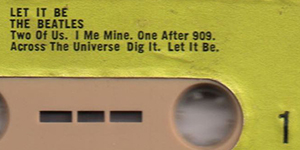 |
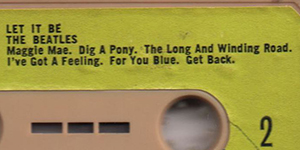 |
|||
 |
 |
The "DP(*2)" logo can often be
found moulded into cassette shells, especially during the
early to mid 1970s. "Made in England" was not embossed the shell. |
||
| OTHER ITEM | ||||
| - |
||||
| LABEL | Lemon Yellow Paper Label with
Parlophone logo |
|||
| MIX | STEREO | |||
| RECORD COMPANY'S NAME | EMI Records (The Gramophone Company Ltd.)
/ An E.M.I. Recording Apple Records |
|||
| CENTRAL REMARK "SOLD IN U.K." |
- | |||
| RECORDING PUBLISHED CREDIT | (P) 1970 | |||
| INLAY FORM | "white" inlay (Foldover) |
|||
| SHELL | Light Grey Shell with 3 windows
(Phillips made?) / embossed "dp" logo mark |
|||
| CASSETTE CASE |
"Norelco"
cases: clear plastic at the front and around the spine area,
and black plastic at the rear. |
|||
| PRINTER CREDIT | Made and Printed in Great Britain |
|||
| COVER DESIGN/ PHOTO/ NOTES | Design: by John Kosh Photographs: Ethan Russell |
|||
| PRODUCER | Reproduced for tape by Phil Spector | |||
| COMMENTS | The original Beatles cassette
release of "Sgt. Peppers" in 1968, through "Abbey Road
(1969)", "Let It Be (August 1970)", and the first
release of most of the other Beatles cassette albums in
September and October, 1970, just months after EMI opened
their new tape duplicating facilities at Hayes in Middlesex
in July, 1970. Prior to the opening of their own plant, EMI's cassette tapes were manufactured for them by the Dutch firm, Phillips, who themselves had pioneered the concept of the musicassette format. These 1968-1972 first edition Beatles cassettes were manufactured in small numbers, and in an "experimental and tentative" design to test a then unknown, but potentially large market, which was still dominated by vinyl, and as such, are scarce and rare desirable finds for collectors today. Sgt. Peppers: released October, 1967, 4 months after vinyl counterpart Abbey Road: released October/November,1969, at the same time as vinyl counterpart. Let It Be: released August,1970, 3 months after vinyl counterpart. The above are known as the "original" cassettes, and were essentially EMI's trial design of the brand new music format, to test the market for cassette tape products - a format designed for 'on the move' listening on car stereo players. Attractive though the "Sgt. Peppers" and "Abbey Road" inlay designs were, it was the "Let It Be", inlay design that became the favoured one, and provided the template for the first cassette releases of the other Beatles albums in September and October 1970. (except "Magical Mystery Tour" and "Yellow Submarine") Rubber soul, Revolver, and A Collection of Beatles Oldies were issued in September, 1970. The 1970/1971 cassettes all had white inlays and aside from the small reproduction of the vinyl album front cover, no art work was included, nor the original liner notes. The tracklistings were printed on the reverse of the inlay whilst the foldovers offered a list of other available Beatles/solo cassettes. The two exceptions to this rule were "Revolver", which had a black spine and a black top above the front cover artwork. It was only available in this form for a short period before being replaced by a standard white inlay design, although this particular version did not promote any other releases. The cassette shell labels during this 1970/1971 "white inlay" period were yellow and carried the new style black-boxed Parlophone/EMI logo or no logo at all. The cassette cases ("Norelco" cases) were clear plastic at the front and around the spine area, and black plastic at the rear. EMI originally issued the Beatles UK albums on cassette tape with re-arranged running orders, the reason for this was that because of the 8-track stereo tapes made at the same time, it was necessary to adjust the endless tape's four tracks to be approximately the same length. Data Packaging Corporation (who also traded as Hellerman Data Packaging Ltd) supplied cassette and 8 track shells, tape and other components to the music industry. The "DP" logo can often be found moulded into cassette shells, especially during the early to mid 1970s. (*1) EMI country code: 1E 262 o 04115 The EMI country codes (introduced on 1 June, 1969): In most cases the EMI Codes are the first two letters of the record's catalog#. These EMI Country Codes were used to indicate the country in which the record was pressed. Note this doesn't necessarily means the record was also released in that country (from Discog). OC / 0C / 1E= UK |
|||
|
TITLE
|
LET IT BE |
|||
| CATALOG NUMBER | TC-PCS 7096 / 1E 262 o 04482 |
|||
|
RELEASE DATE
|
September 1970? / Second Issue | |||
| TRACK LISTING | SIDE 1 | SIDE 2 | ||
| Two Of Us [A1] |
Maggie Mae [A7] |
|||
| I Me Mine [A4] | Dig A Pony [A2] |
|||
| One After 909 [B2] |
The Long And Winding Road [B3] |
|||
| Across The Universe [A3] |
I Got A Feeling [B1] |
|||
| Dig It [A5] |
For You Blue [B4] |
|||
| Let It Be [A6] | Get Back [B5] | |||
| CASSETTE CASE AND TAPE |
CASE FRONT | CASE BACK | SIDE 1 --> Click! | SIDE 2 --> Click! |
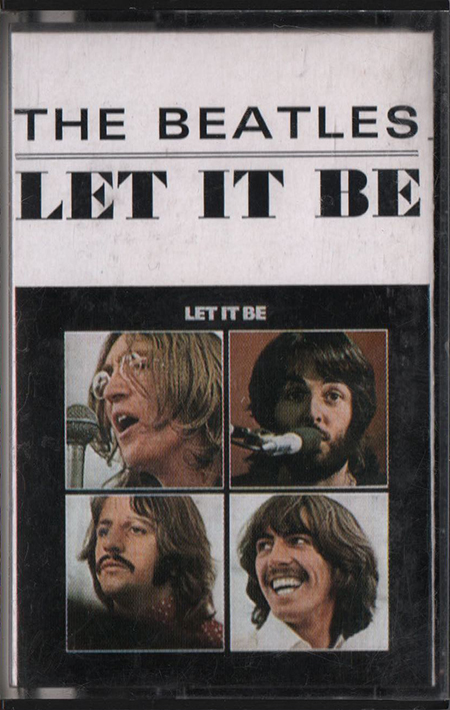 |
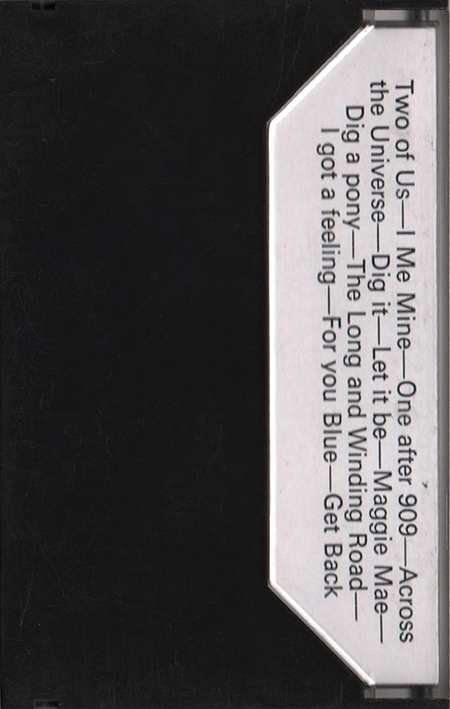 |
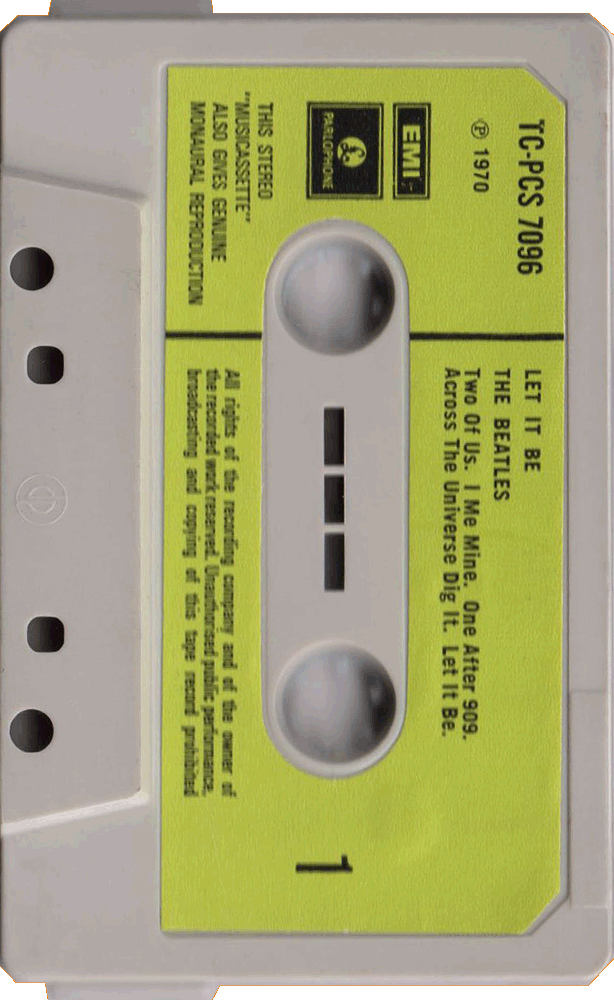 |
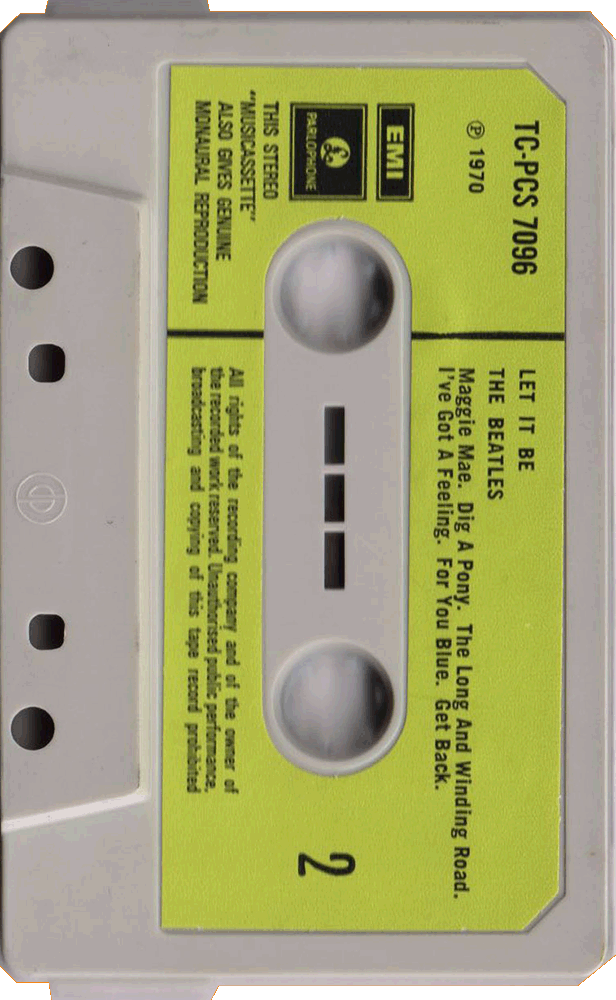 |
|
| The cassette cases ("Norelco" cases)
were clear plastic at the front and around the spine area,
and black plastic at the rear. |
This UK issue of "Let It Be" has Lemon Yellow paper
label with EMI/Parlophone logo. Has the 3 windows shell. |
|||
| INLAY |
INLAY: FRONT | INLAY: INSIDE |
||
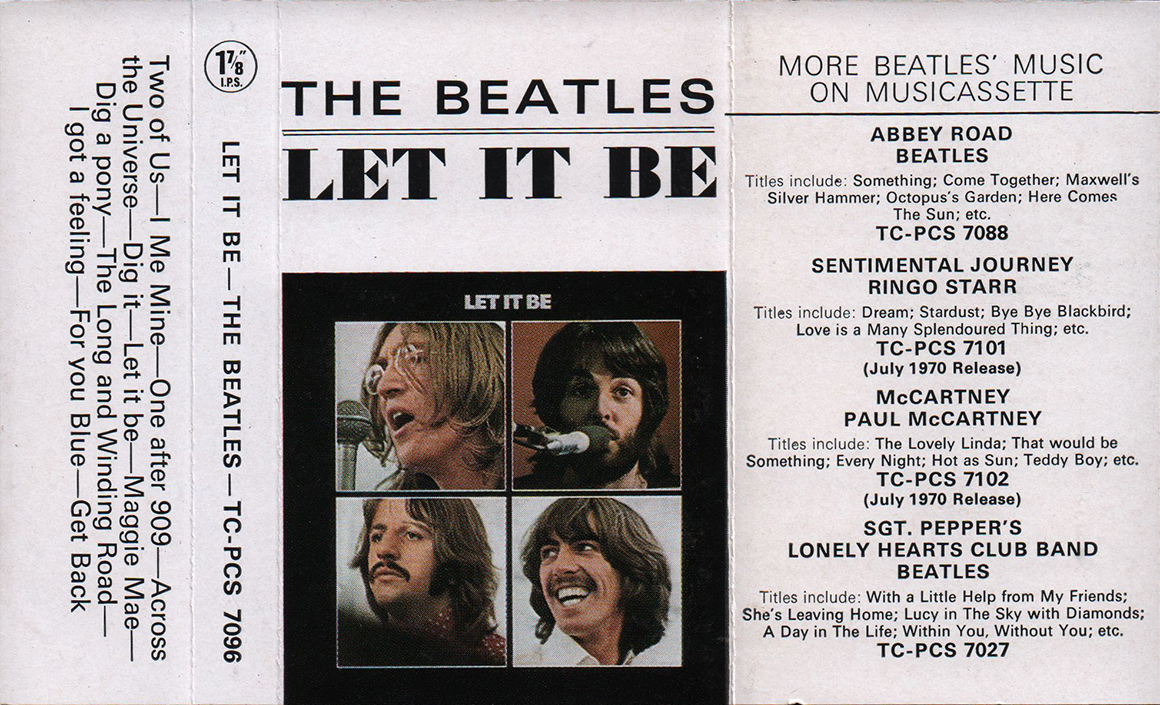 |
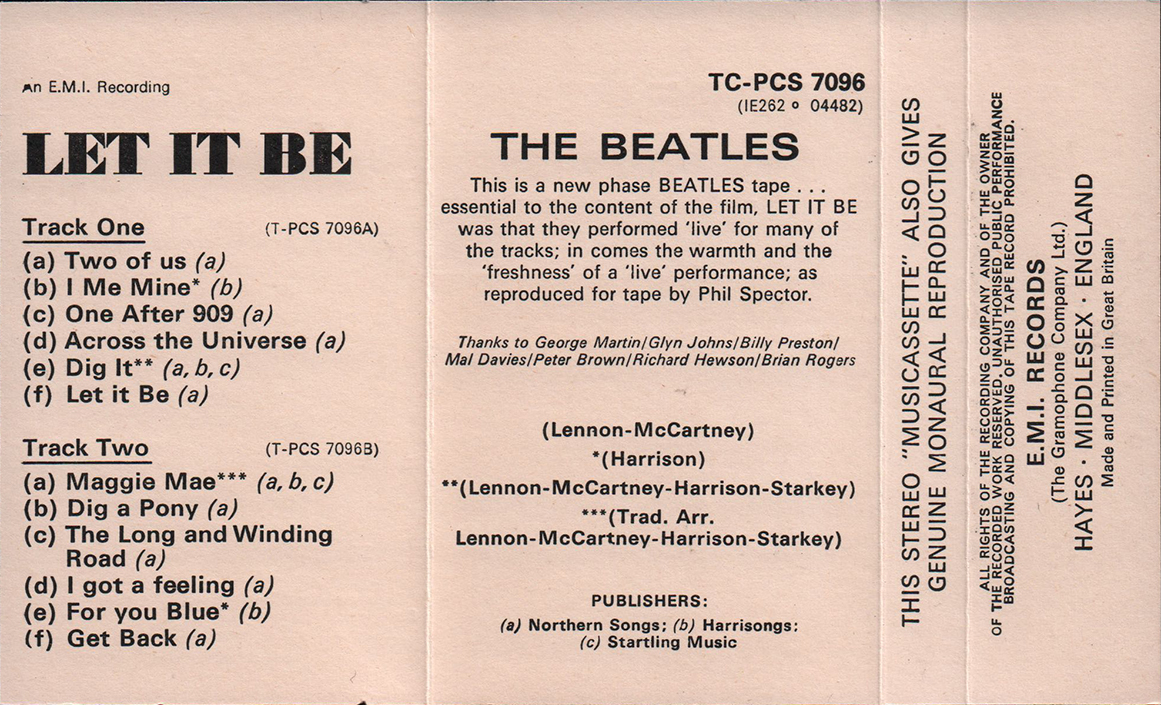 |
|||
| The 1970/71 cassettes had white inlays
and, aside from the small reproduction of the front cover,
no artwork was included nor the original liner notes. The
tracklistings were printed on the reverse of the inlay
whilst the foldovers advertised other available Beatles/solo
cassettes. |
||||
| INLAY: FRONT CLOSE UP | ||||
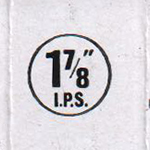 |
The
circular 1 7/8 " I.P.S. mark was printed at the spine. As the standard tape speed for a compact cassette is 1 ⅞ ips (1.875 inches per second). |
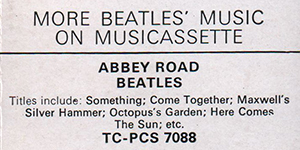 |
The tracklistings were
printed on the reverse of the inlay whilst the foldovers
advertised other available Beatles cassettes. |
|
| INLAY: FRONT CLOSE UP | ||||
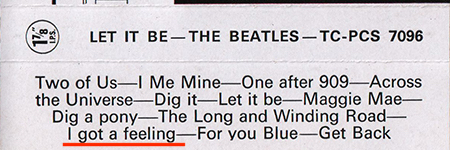 |
EMI
originally issued the Beatles UK albums on cassette tape
with re-arranged running orders, the reason for this was
that because of the 8-track stereo tapes made at the same
time, it was necessary to adjust the endless tape's four
tracks to be approximately the same length. Inlay incorrectly spells track 4 on side-2 as "I got a feeling". |
|||
| INLAY: INSIDE CLOSE UP | ||||
 |
"Apple Records" credit was removed
on the inlay. |
 |
Catalog number "TC-PCS 7096" and the EMI country code (*1) were printed on the inlay. | |
| INLAY: INSIDE CLOSE UP | ||||
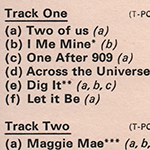 |
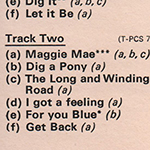 |
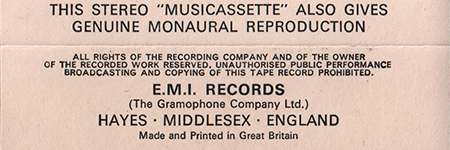 |
||
| The tracklistings were printed on the reverse of
the inlay. EMI originally issued the Beatles UK albums on
cassette tape with re-arranged running orders. |
"E.M.I. Records (The Gramophone Company Ltd.)" credit was printed at the bottom of the inside of the inlay. | |||
| LABEL CLOSE UP | ||||
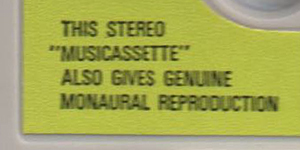 |
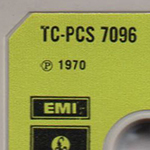 |
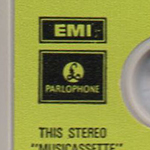 |
2nd. issues had lemon
yellow label, and printed on the new style black box Pharlophone
/ EMI logo introduced in September / October, 1970. |
|
| LABEL CLOSE UP | ||||
| SIDE
1 |
SIDE 2 |
The
tracklistings
were printed on the reverse of the inlay. EMI originally
issued the Beatles UK albums on cassette tape with
re-arranged running orders. Has the 3 windows shell. |
||
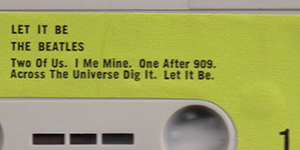 |
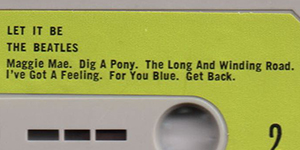 |
|||
 |
 |
The "DP(*2)" logo can often be
found moulded into cassette shells, especially during the
early to mid 1970s. "Made in England" was not embossed the shell. |
||
| OTHER ITEM | ||||
| - |
||||
| LABEL | Lemon Yellow Paper Label with
EMI/Parlophone logo in black box |
|||
| MIX | STEREO | |||
| RECORD COMPANY'S NAME | EMI Records (The Gramophone Company Ltd.)
/ An E.M.I. Recording * The credit "APPLE RECORDS" was removed on the inlay. |
|||
| CENTRAL REMARK "SOLD IN U.K." |
- | |||
| RECORDING PUBLISHED CREDIT | (P) 1970 | |||
| INLAY FORM | "white" inlay (Foldover) |
|||
| SHELL | Light Grey Shell with 3 windows
(Phillips made?) / embossed "dp" logo mark |
|||
| CASSETTE CASE |
"Norelco"
cases:
clear plastic at the front and around the spine area, and
black plastic at the rear. |
|||
| PRINTER CREDIT | Made and Printed in Great Britain |
|||
| COVER DESIGN/ PHOTO/ NOTES | Design: by John Kosh Photographs: Ethan Russell |
|||
| PRODUCER | Reproduced for tape by Phil Spector | |||
| COMMENTS | The original Beatles cassette
release of "Sgt. Peppers" in 1968, through "Abbey Road
(1969)", "Let It Be (August 1970)", and the first
release of most of the other Beatles cassette albums in
September and October, 1970, just months after EMI opened
their new tape duplicating facilities at Hayes in Middlesex
in July, 1970. Prior to the opening of their own plant, EMI's cassette tapes were manufactured for them by the Dutch firm, Phillips, who themselves had pioneered the concept of the musicassette format. These 1968-1972 first edition Beatles cassettes were manufactured in small numbers, and in an "experimental and tentative" design to test a then unknown, but potentially large market, which was still dominated by vinyl, and as such, are scarce and rare desirable finds for collectors today. Sgt. Peppers: released October, 1967, 4 months after vinyl counterpart Abbey Road: released October/November,1969, at the same time as vinyl counterpart. Let It Be: released August,1970, 3 months after vinyl counterpart. The above are known as the "original" cassettes, and were essentially EMI's trial design of the brand new music format, to test the market for cassette tape products - a format designed for 'on the move' listening on car stereo players. Attractive though the "Sgt. Peppers" and "Abbey Road" inlay designs were, it was the "Let It Be", inlay design that became the favoured one, and provided the template for the first cassette releases of the other Beatles albums in September and October 1970. (except "Magical Mystery Tour" and "Yellow Submarine") Rubber soul, Revolver, and A Collection of Beatles Oldies were issued in September, 1970. The 1970/1971 cassettes all had white inlays and aside from the small reproduction of the vinyl album front cover, no art work was included, nor the original liner notes. The tracklistings were printed on the reverse of the inlay whilst the foldovers offered a list of other available Beatles/solo cassettes. The two exceptions to this rule were "Revolver", which had a black spine and a black top above the front cover artwork. It was only available in this form for a short period before being replaced by a standard white inlay design, although this particular version did not promote any other releases. 2nd. issues had lemon yellow label, and printed on the new style black box Pharlophone / EMI logo introduced in late 1970 (maybe). The cassette shell labels during this 1970/1971 "white inlay" period were yellow and carried the black-boxed Parlophone/EMI logo or no logo at all. The cassette cases ("Norelco" cases) were clear plastic at the front and around the spine area, and black plastic at the rear. EMI originally issued the Beatles UK albums on cassette tape with re-arranged running orders, the reason for this was that because of the 8-track stereo tapes made at the same time, it was necessary to adjust the endless tape's four tracks to be approximately the same length. Data Packaging Corporation (who also traded as Hellerman Data Packaging Ltd) supplied cassette and 8 track shells, tape and other components to the music industry. The "DP" logo can often be found moulded into cassette shells, especially during the early to mid 1970s. (*1) EMI country code: 1E 262 o 04115 The EMI country codes (introduced on 1 June, 1969): In most cases the EMI Codes are the first two letters of the record's catalog#. These EMI Country Codes were used to indicate the country in which the record was pressed. Note this doesn't necessarily means the record was also released in that country (from Discog). OC / 0C / 1E= UK |
|||
|
TITLE
|
LET IT BE |
|||
| CATALOG NUMBER | TC-PCS 7096 / 1E 262 o 04482 |
|||
|
RELEASE DATE
|
late 1970? / Third Issue | |||
| TRACK LISTING | SIDE 1 | SIDE 2 | ||
| Two Of Us [A1] |
Maggie Mae [A7] |
|||
| I Me Mine [A4] | Dig A Pony [A2] |
|||
| One After 909 [B2] |
The Long And Winding Road [B3] |
|||
| Across The Universe [A3] |
I Got A Feeling [B1] |
|||
| Dig It [A5] |
For You Blue [B4] |
|||
| Let It Be [A6] | Get Back [B5] | |||
| CASSETTE CASE AND TAPE |
CASE FRONT | CASE BACK | SIDE 1 --> Click! | SIDE 2 --> Click! |
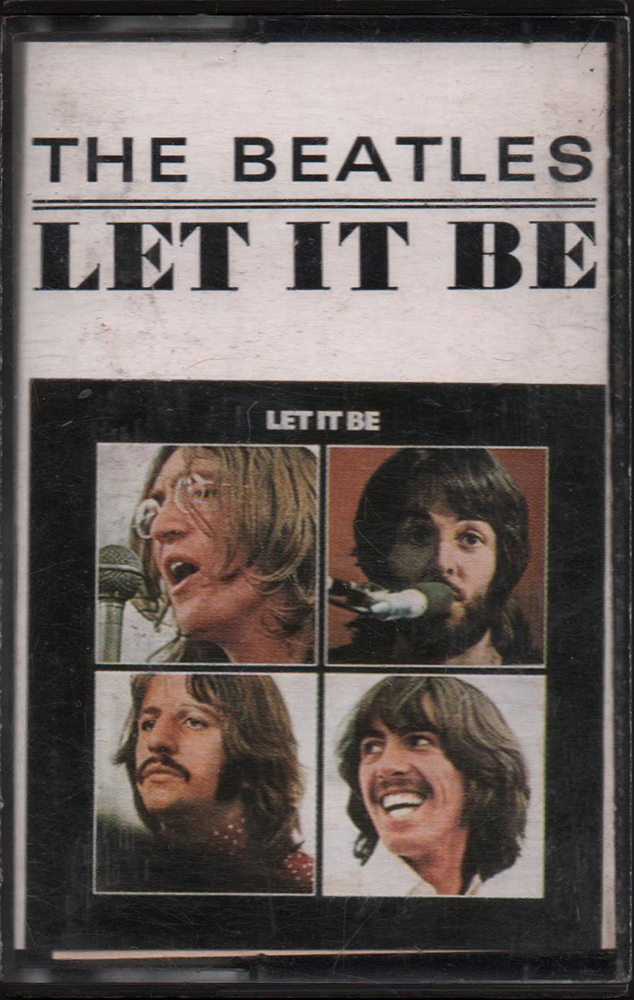 |
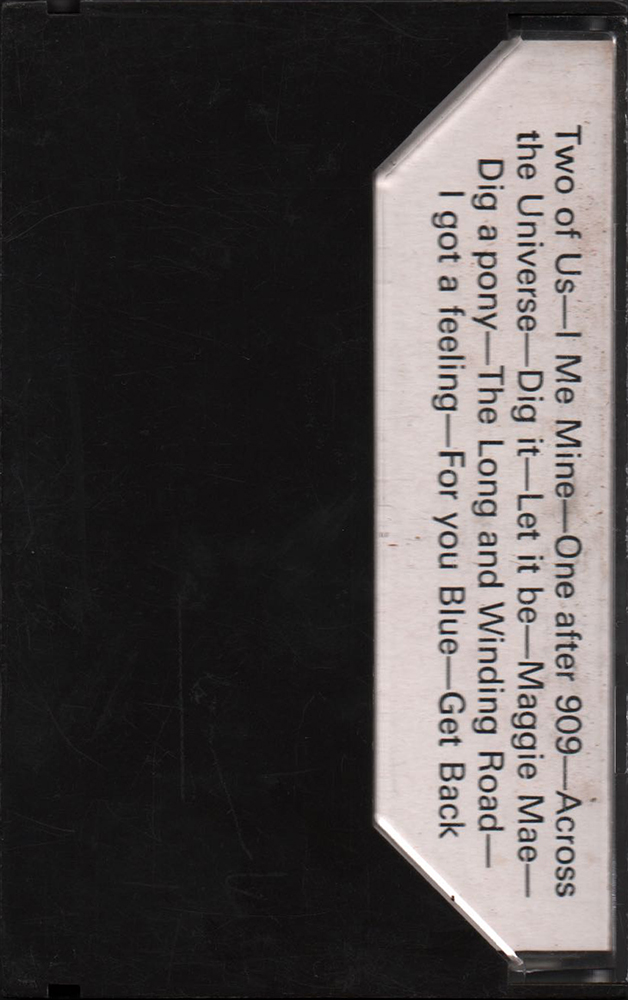 |
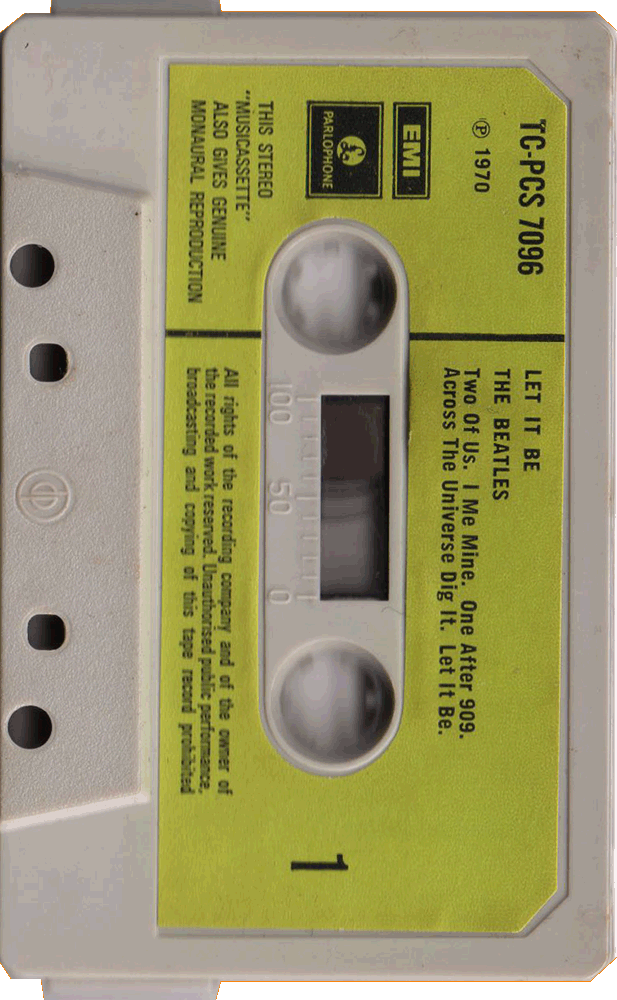 |
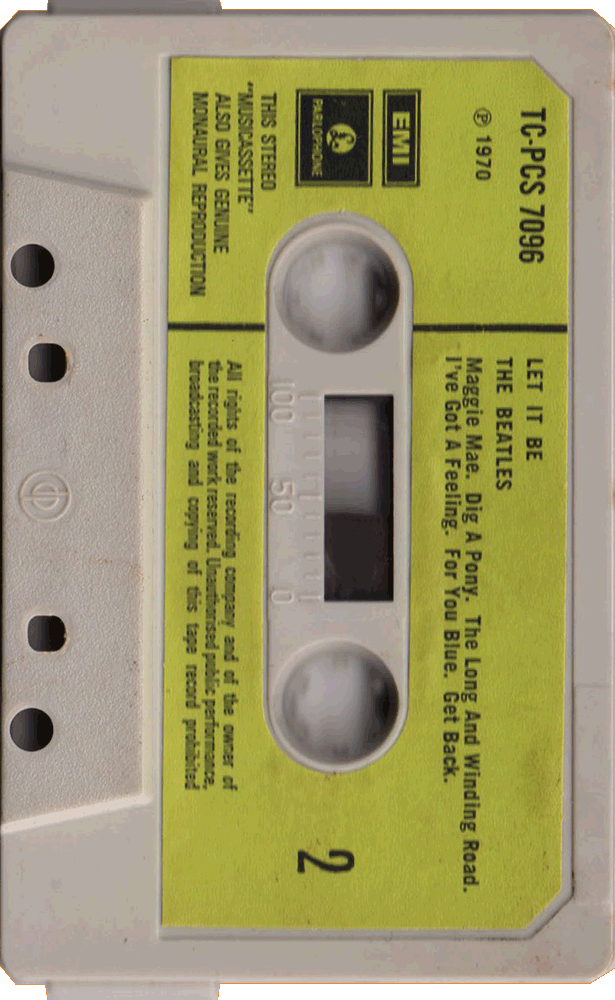 |
|
| The cassette cases ("Norelco" cases)
were clear plastic at the front and around the spine area,
and black plastic at the rear. |
This UK issue of "Let It Be" has Lemon Yellow paper
label with EMI/Parlophone logo. |
|||
| INLAY |
INLAY: FRONT | INLAY: INSIDE |
||
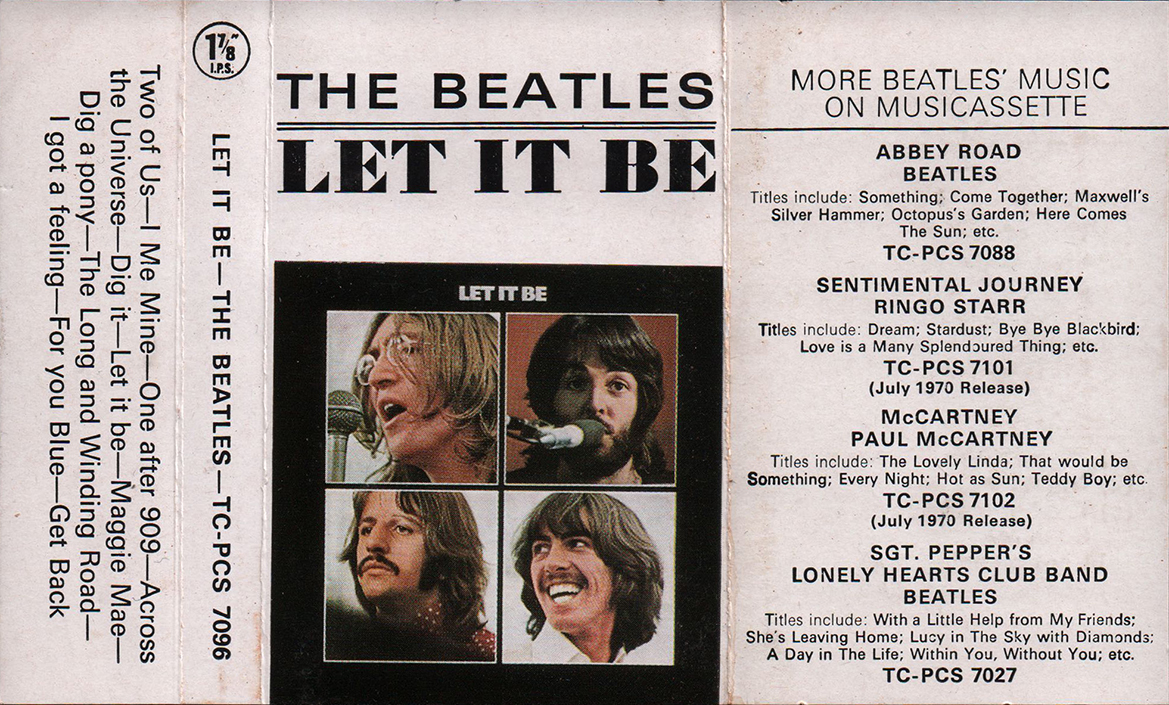 |
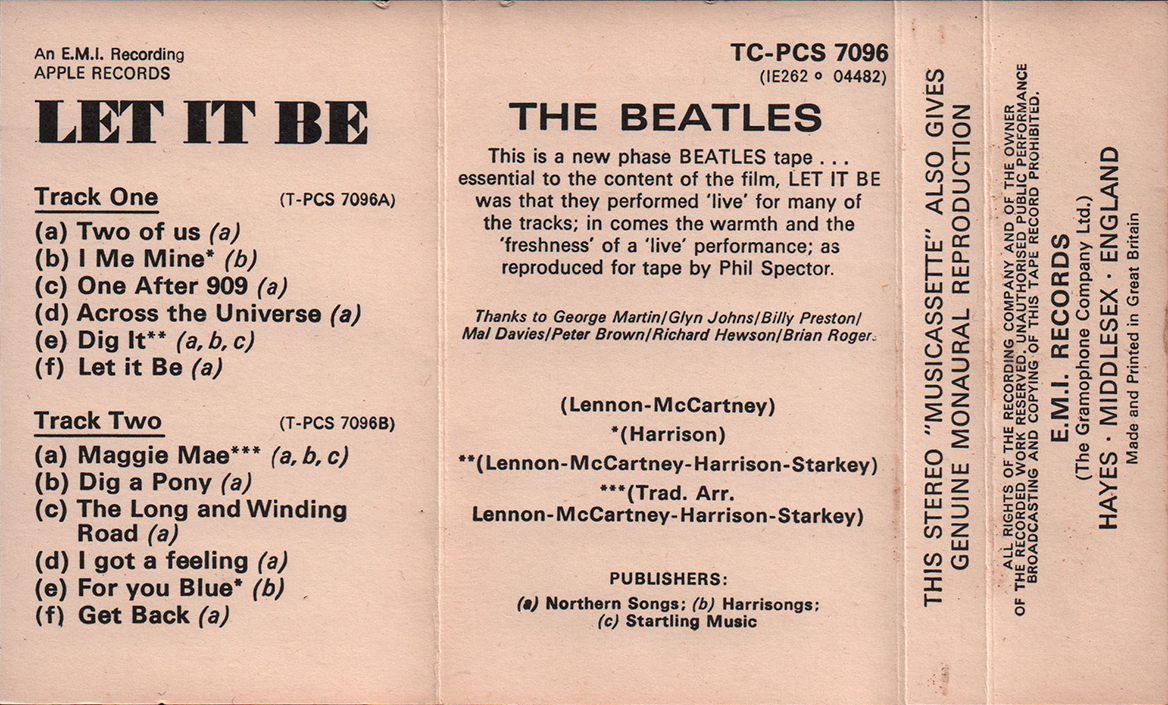 |
|||
| The 1970/71 cassettes had white inlays
and, aside from the small reproduction of the front cover,
no artwork was included nor the original liner notes. The
tracklistings were printed on the reverse of the inlay
whilst the foldovers advertised other available Beatles/solo
cassettes. |
||||
| INLAY: FRONT CLOSE UP | ||||
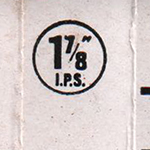 |
The
circular 1 7/8 " I.P.S. mark was printed at the spine. As the standard tape speed for a compact cassette is 1 ⅞ ips (1.875 inches per second). |
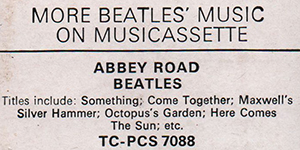 |
The tracklistings were
printed on the reverse of the inlay whilst the foldovers
advertised other available Beatles cassettes. |
|
| INLAY: FRONT CLOSE UP | ||||
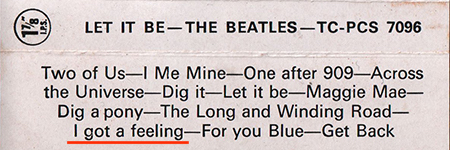 |
EMI
originally
issued the Beatles UK albums on cassette tape with
re-arranged running orders, the reason for this was that
because of the 8-track stereo tapes made at the same time,
it was necessary to adjust the endless tape's four tracks to
be approximately the same length. Inlay incorrectly spells track 4 on side-2 as "I got a feeling". |
|||
| INLAY: INSIDE CLOSE UP | ||||
 |
"Apple Records" credit was added
on the inlay again. |
 |
Catalog number "TC-PCS 7096" and the EMI country code (*1) were printed on the inlay. | |
| INLAY: INSIDE CLOSE UP | ||||
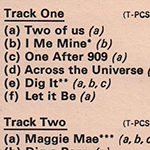 |
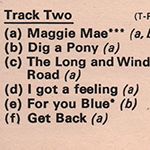 |
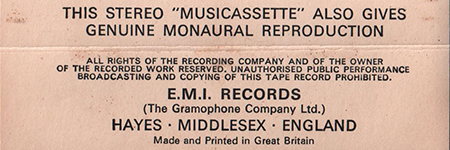 |
||
| The tracklistings were printed on the reverse of
the inlay. EMI originally issued the Beatles UK albums on
cassette tape with re-arranged running orders. |
"E.M.I. Records (The Gramophone Company Ltd.)" credit was printed at the bottom of the inside of the inlay. | |||
 |
Publisher's name was printed
at the bottom of the inlay. |
|||
| LABEL CLOSE UP | ||||
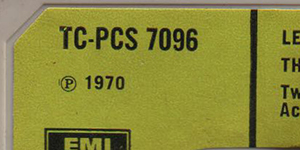 |
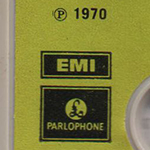 |
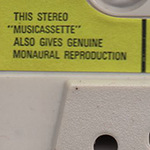 |
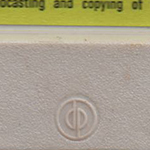 |
|
| 3rd. issues had lemon yellow label, and printed on the new style black box Pharlophone / EMI logo introduced in September / October, 1970. | Containing content as a prerecorded
cassette is called "Musicassette" |
The "DP(*2)" logo can often
be found moulded into cassette shells, especially during the
early to mid 1970s. |
||
| LABEL CLOSE UP | ||||
| SIDE
1 |
SIDE 2 |
The
tracklistings
were
printed on the reverse of the inlay. EMI originally issued
the Beatles UK albums on cassette tape with re-arranged
running orders. |
||
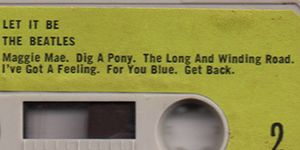 |
 |
|||
 |
"Made in England / Made in U.S.A." were not embossed the shell. | |||
| OTHER ITEM | ||||
| - |
||||
| LABEL | Lemon Yellow Paper Label with
EMI/Parlophone logo in black box |
|||
| MIX | STEREO | |||
| RECORD COMPANY'S NAME | EMI Records (The Gramophone Company Ltd.)
/ An E.M.I. Recording * The credit "APPLE RECORDS" was added on the inlay. |
|||
| CENTRAL REMARK "SOLD IN U.K." |
- | |||
| RECORDING PUBLISHED CREDIT | (P) 1970 | |||
| INLAY FORM | "white" inlay (Foldover) |
|||
| SHELL | Light Grey Shell / embossed "dp"
logo mark |
|||
| CASSETTE CASE |
"Norelco"
cases:
clear
plastic at the front and around the spine area, and black
plastic at the rear. |
|||
| PRINTER CREDIT | Made and Printed in Great Britain |
|||
| COVER DESIGN/ PHOTO/ NOTES | Design: by John Kosh Photographs: Ethan Russell |
|||
| PRODUCER | Reproduced for tape by Phil Spector | |||
| COMMENTS | The original Beatles cassette
release of "Sgt. Peppers" in 1968, through "Abbey Road
(1969)", "Let It Be (August 1970)", and the first
release of most of the other Beatles cassette albums in
September and October, 1970, just months after EMI opened
their new tape duplicating facilities at Hayes in Middlesex
in July, 1970. Prior to the opening of their own plant, EMI's cassette tapes were manufactured for them by the Dutch firm, Phillips, who themselves had pioneered the concept of the musicassette format. These 1968-1972 first edition Beatles cassettes were manufactured in small numbers, and in an "experimental and tentative" design to test a then unknown, but potentially large market, which was still dominated by vinyl, and as such, are scarce and rare desirable finds for collectors today. Sgt. Peppers: released October, 1967, 4 months after vinyl counterpart Abbey Road: released October/November,1969, at the same time as vinyl counterpart. Let It Be: released August,1970, 3 months after vinyl counterpart. The above are known as the "original" cassettes, and were essentially EMI's trial design of the brand new music format, to test the market for cassette tape products - a format designed for 'on the move' listening on car stereo players. Attractive though the "Sgt. Peppers" and "Abbey Road" inlay designs were, it was the "Let It Be", inlay design that became the favoured one, and provided the template for the first cassette releases of the other Beatles albums in September and October 1970. (except "Magical Mystery Tour" and "Yellow Submarine") Rubber soul, Revolver, and A Collection of Beatles Oldies were issued in September, 1970. The 1970/1971 cassettes all had white inlays and aside from the small reproduction of the vinyl album front cover, no art work was included, nor the original liner notes. The tracklistings were printed on the reverse of the inlay whilst the foldovers offered a list of other available Beatles/solo cassettes. The two exceptions to this rule were "Revolver", which had a black spine and a black top above the front cover artwork. It was only available in this form for a short period before being replaced by a standard white inlay design, although this particular version did not promote any other releases. 2nd. issues had lemon yellow label, and printed on the new style black box Pharlophone / EMI logo introduced in late 1970 (maybe). The cassette shell labels during this 1970/1971 "white inlay" period were yellow and carried the black-boxed Parlophone/EMI logo or no logo at all. The cassette cases ("Norelco" cases) were clear plastic at the front and around the spine area, and black plastic at the rear. EMI originally issued the Beatles UK albums on cassette tape with re-arranged running orders, the reason for this was that because of the 8-track stereo tapes made at the same time, it was necessary to adjust the endless tape's four tracks to be approximately the same length. Data Packaging Corporation (who also traded as Hellerman Data Packaging Ltd) supplied cassette and 8 track shells, tape and other components to the music industry. The "DP" logo can often be found moulded into cassette shells, especially during the early to mid 1970s. (*1) EMI country code: 1E 262 o 04115 The EMI country codes (introduced on 1 June, 1969): In most cases the EMI Codes are the first two letters of the record's catalog#. These EMI Country Codes were used to indicate the country in which the record was pressed. Note this doesn't necessarily means the record was also released in that country (from Discog). OC / 0C / 1E= UK |
|||
|
TITLE
|
LET IT BE |
|||
| CATALOG NUMBER | TC-PCS 7096 / 1E 262 o 04482 |
|||
|
RELEASE DATE
|
middle 1971? / 4th. Issue? | |||
| TRACK LISTING | SIDE 1 | SIDE 2 | ||
| Two Of Us [A1] |
Maggie Mae [A7] |
|||
| I Me Mine [A4] | Dig A Pony [A2] |
|||
| One After 909 [B2] |
The Long And Winding Road [B3] |
|||
| Across The Universe [A3] |
I Got A Feeling [B1] |
|||
| Dig It [A5] |
For You Blue [B4] |
|||
| Let It Be [A6] | Get Back [B5] | |||
| CASSETTE CASE AND TAPE |
CASE FRONT | CASE BACK | SIDE 1 --> Click! | SIDE 2 --> Click! |
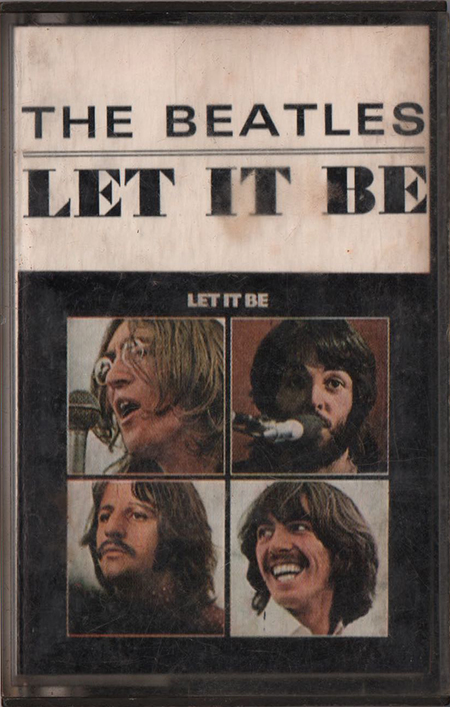 |
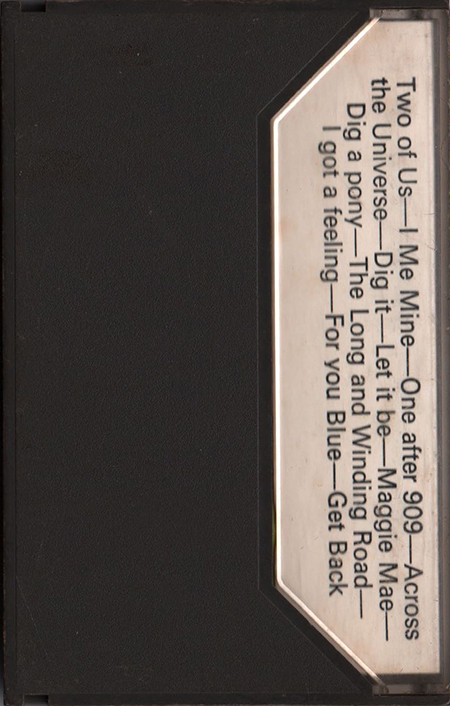 |
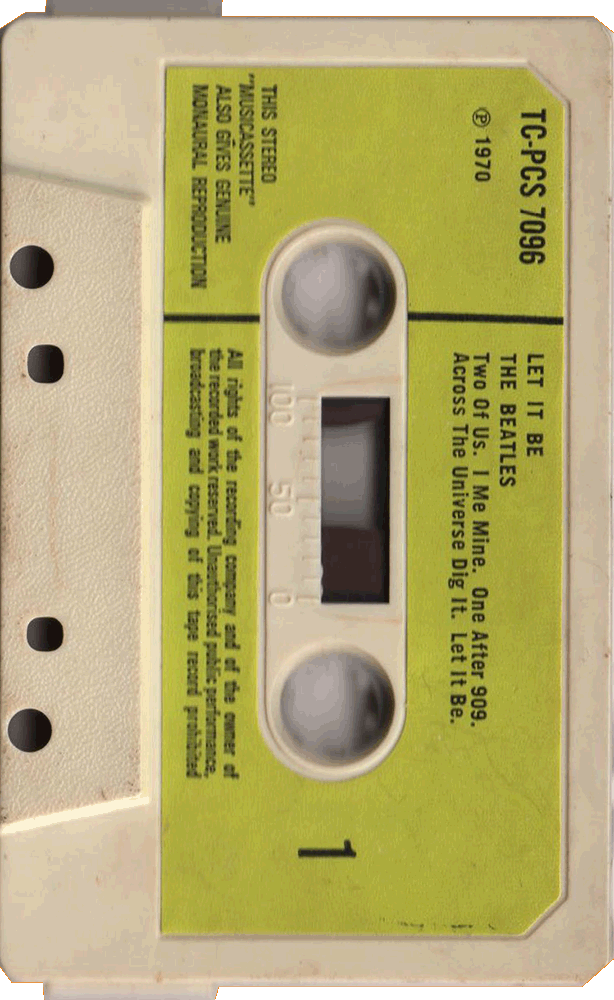 |
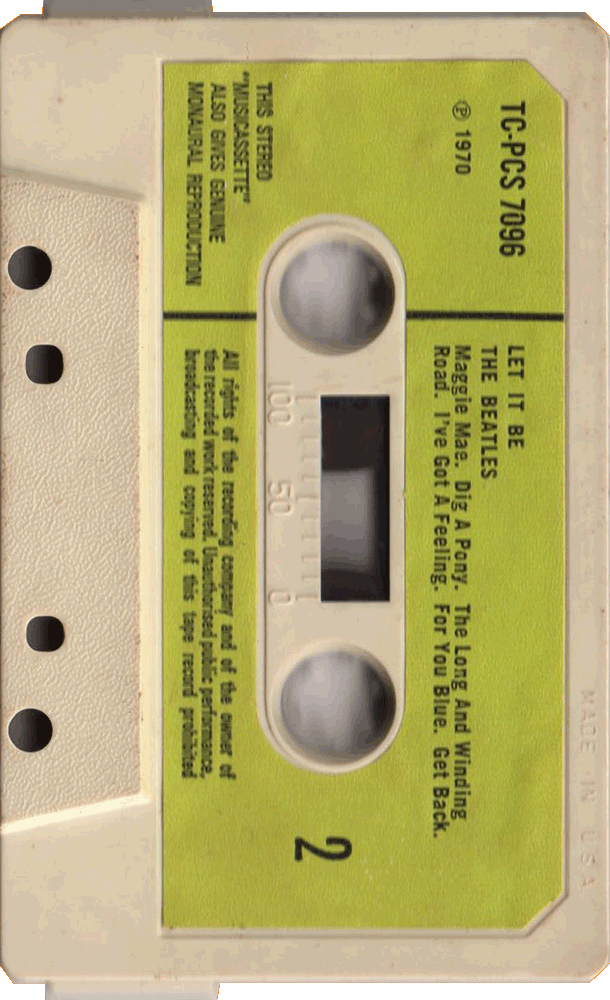 |
|
| The cassette cases ("Norelco" cases)
were clear plastic at the front and around the spine area,
and black plastic at the rear. |
This UK issue of "Let It Be" has Lemon Yellow paper label
with Parlophone logo |
|||
| INLAY |
INLAY: FRONT | INLAY: INSIDE |
||
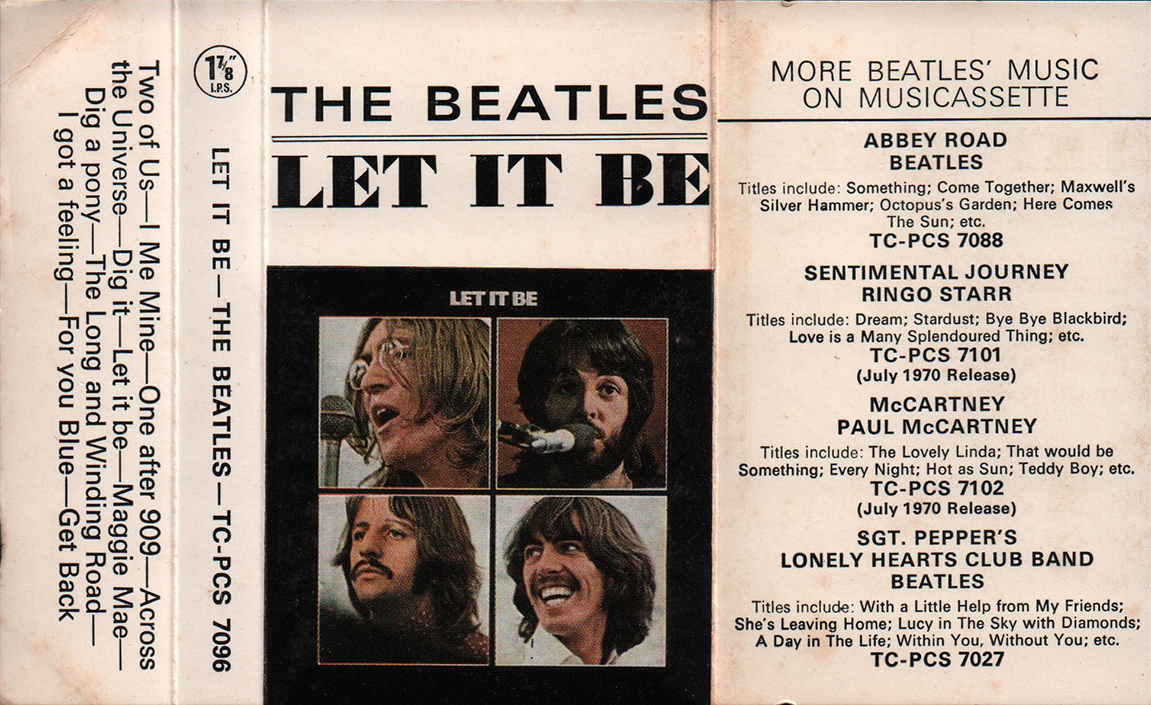 |
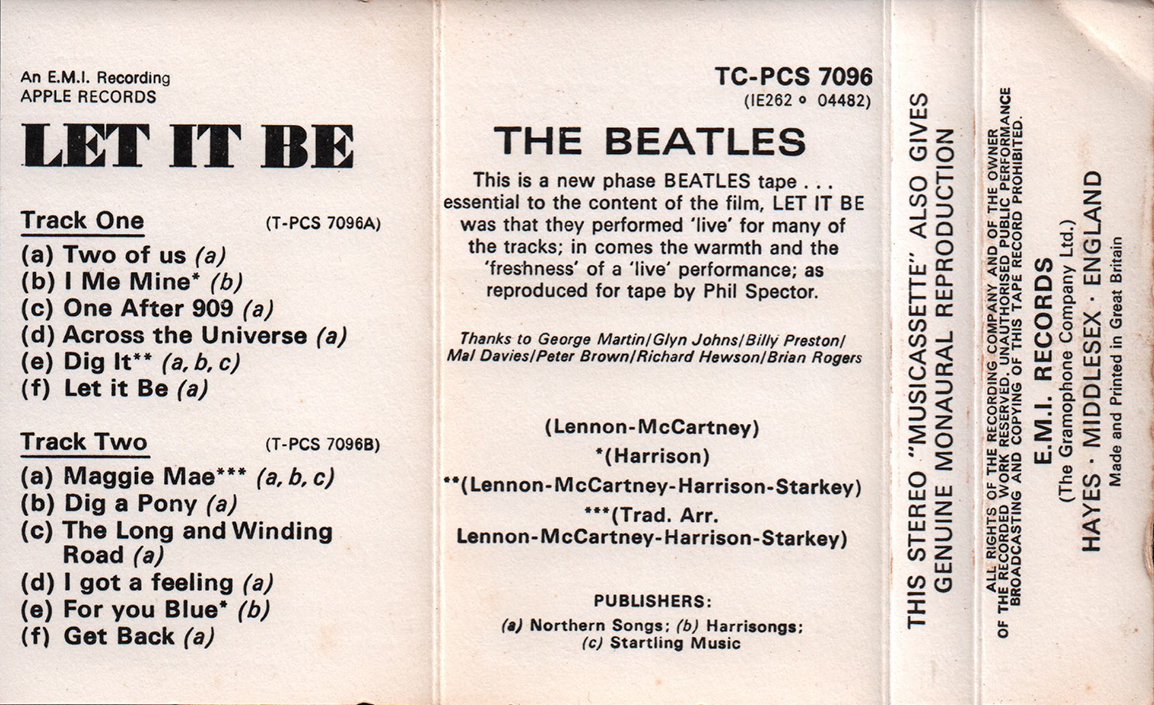 |
|||
| The 1970/71 cassettes had white inlays
and, aside from the small reproduction of the front cover,
no artwork was included nor the original liner notes. The
tracklistings were printed on the reverse of the inlay
whilst the foldovers advertised other available Beatles/solo
cassettes. |
||||
| INLAY: FRONT CLOSE UP | ||||
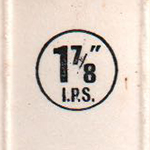 |
The
circular 1 7/8 " I.P.S. mark was printed at the spine. As the standard tape speed for a compact cassette is 1 ⅞ ips (1.875 inches per second). |
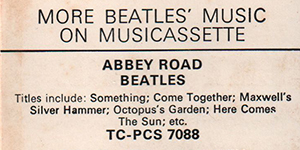 |
The tracklistings were
printed on the reverse of the inlay whilst the foldovers
advertised other available Beatles cassettes. |
|
| INLAY: FRONT CLOSE UP | ||||
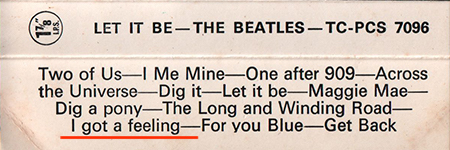 |
EMI
originally issued the Beatles UK albums on cassette tape
with re-arranged running orders, the reason for this was
that because of the 8-track stereo tapes made at the same
time, it was necessary to adjust the endless tape's four
tracks to be approximately the same length. Inlay incorrectly spells track 4 on side-2 as "I got a feeling". |
|||
| INLAY: INSIDE CLOSE UP | ||||
 |
"Apple Records" credit was added
on the inlay again (maybe). |
 |
Catalog number "TC-PCS 7096" and the EMI country code (*1) were printed on the inlay. | |
| INLAY: INSIDE CLOSE UP | ||||
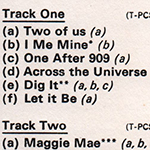 |
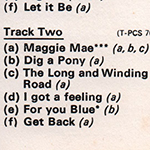 |
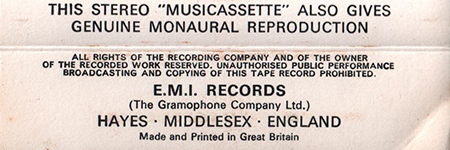 |
||
| The tracklistings were printed on the reverse of
the inlay. EMI originally issued the Beatles UK albums on
cassette tape with re-arranged running orders. |
"E.M.I. Records (The Gramophone Company Ltd.)" credit was printed at the bottom of the inside of the inlay. | |||
| LABEL CLOSE UP | ||||
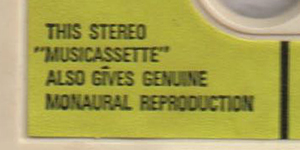 |
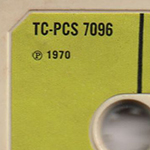 |
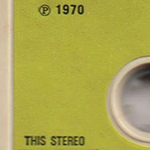 |
The cassette shell
labels during this 1970/1971 "white inlay" period were NO
logo on the label. |
|
| LABEL CLOSE UP | ||||
| SIDE
1 |
SIDE 2 |
On
side-2 of the label, with the NEW track listing layout
(2 lines) instead of the lemon yellow label with EMI
logo. |
||
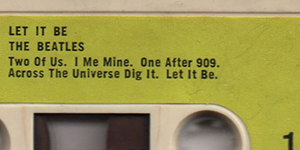 |
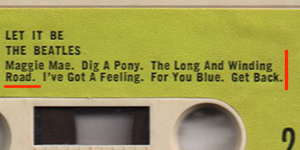 |
|||
 |
 |
The "DP(*2)" logo was not
found moulded into cassette shells. "Made in U.S.A." was embossed the shell. |
||
| OTHER ITEM | ||||
| - |
||||
| LABEL | Lemon Yellow Paper Label without
Parlophone logo type-1 |
|||
| MIX | STEREO | |||
| RECORD COMPANY'S NAME | EMI Records (The Gramophone Company Ltd.)
/ An E.M.I. Recording * The credit "APPLE RECORDS" was added on the inlay. |
|||
| CENTRAL REMARK "SOLD IN U.K." |
- | |||
| RECORDING PUBLISHED CREDIT | (P) 1970 | |||
| INLAY FORM | "white" inlay (Foldover) |
|||
| SHELL | White Shell / embossed "MADE IN
USA" |
|||
| CASSETTE CASE |
"Norelco"
cases:
clear
plastic at the front and around the spine area, and black
plastic at the rear. |
|||
| PRINTER CREDIT | Made and Printed in Great Britain |
|||
| COVER DESIGN/ PHOTO/ NOTES | Design: by John Kosh Photographs: Ethan Russell |
|||
| PRODUCER | Reproduced for tape by Phil Spector | |||
| COMMENTS | The original Beatles cassette
release of "Sgt. Peppers" in 1968, through "Abbey Road
(1969)", "Let It Be (August 1970)", and the first
release of most of the other Beatles cassette albums in
September and October, 1970, just months after EMI opened
their new tape duplicating facilities at Hayes in Middlesex
in July, 1970. Prior to the opening of their own plant, EMI's cassette tapes were manufactured for them by the Dutch firm, Phillips, who themselves had pioneered the concept of the musicassette format. These 1968-1972 first edition Beatles cassettes were manufactured in small numbers, and in an "experimental and tentative" design to test a then unknown, but potentially large market, which was still dominated by vinyl, and as such, are scarce and rare desirable finds for collectors today. Sgt. Peppers: released October, 1967, 4 months after vinyl counterpart Abbey Road: released October/November,1969, at the same time as vinyl counterpart. Let It Be: released August,1970, 3 months after vinyl counterpart. The above are known as the "original" cassettes, and were essentially EMI's trial design of the brand new music format, to test the market for cassette tape products - a format designed for 'on the move' listening on car stereo players. Attractive though the "Sgt. Peppers" and "Abbey Road" inlay designs were, it was the "Let It Be", inlay design that became the favoured one, and provided the template for the first cassette releases of the other Beatles albums in September and October 1970. (except "Magical Mystery Tour" and "Yellow Submarine") Rubber soul, Revolver, and A Collection of Beatles Oldies were issued in September, 1970. The 1970/1971 cassettes all had white inlays and aside from the small reproduction of the vinyl album front cover, no art work was included, nor the original liner notes. The tracklistings were printed on the reverse of the inlay whilst the foldovers offered a list of other available Beatles/solo cassettes. The two exceptions to this rule were "Revolver", which had a black spine and a black top above the front cover artwork. It was only available in this form for a short period before being replaced by a standard white inlay design, although this particular version did not promote any other releases. 2nd. issues had lemon yellow label, and printed on the new style black box Pharlophone / EMI logo introduced in late 1970 (maybe). The cassette shell labels during this 1970/1971 "white inlay" period were yellow and carried the black-boxed Parlophone/EMI logo or no logo at all. On side-2 of the label, with the NEW track listing layout (2 lines) instead of the lemon yellow label with EMI logo. The cassette cases ("Norelco" cases) were clear plastic at the front and around the spine area, and black plastic at the rear. "MADE IN U.S.A." was embossed the shell. EMI originally issued the Beatles UK albums on cassette tape with re-arranged running orders, the reason for this was that because of the 8-track stereo tapes made at the same time, it was necessary to adjust the endless tape's four tracks to be approximately the same length. Data Packaging Corporation (who also traded as Hellerman Data Packaging Ltd) supplied cassette and 8 track shells, tape and other components to the music industry. The "DP" logo can often be found moulded into cassette shells, especially during the early to mid 1970s. (*1) EMI country code: 1E 262 o 04115 The EMI country codes (introduced on 1 June, 1969): In most cases the EMI Codes are the first two letters of the record's catalog#. These EMI Country Codes were used to indicate the country in which the record was pressed. Note this doesn't necessarily means the record was also released in that country (from Discog). OC / 0C / 1E= UK |
|||
|
TITLE
|
LET IT BE |
|||
| CATALOG NUMBER | TC-PCS 7096 / 1E 262 o 04482 |
|||
|
RELEASE DATE
|
late 1971? / 5th. Issue? | |||
| TRACK LISTING | SIDE 1 | SIDE 2 | ||
| Two Of Us [A1] |
Maggie Mae [A7] |
|||
| I Me Mine [A4] | Dig A Pony [A2] |
|||
| One After 909 [B2] |
The Long And Winding Road [B3] |
|||
| Across The Universe [A3] |
I Got A Feeling [B1] |
|||
| Dig It [A5] |
For You Blue [B4] |
|||
| Let It Be [A6] | Get Back [B5] | |||
| CASSETTE CASE AND TAPE |
CASE FRONT | CASE BACK | SIDE 1 --> Click! | SIDE 2 --> Click! |
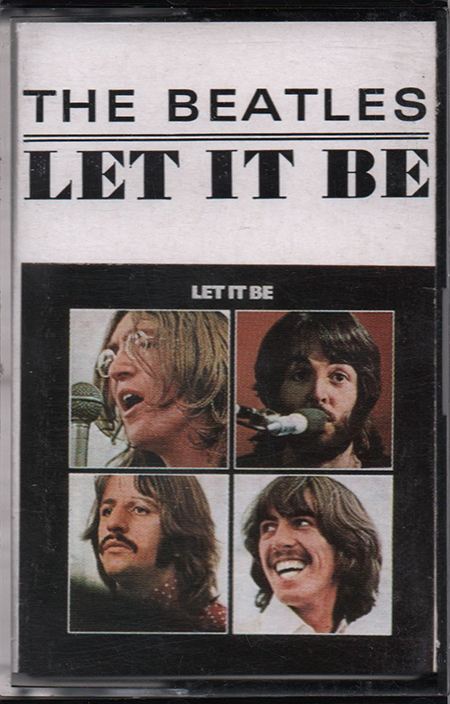 |
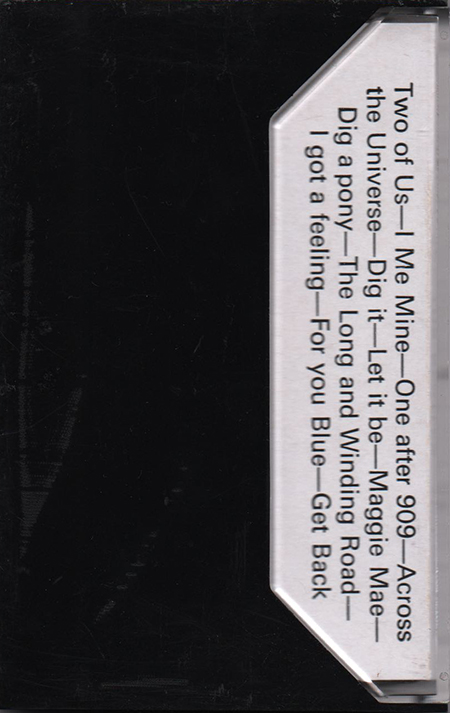 |
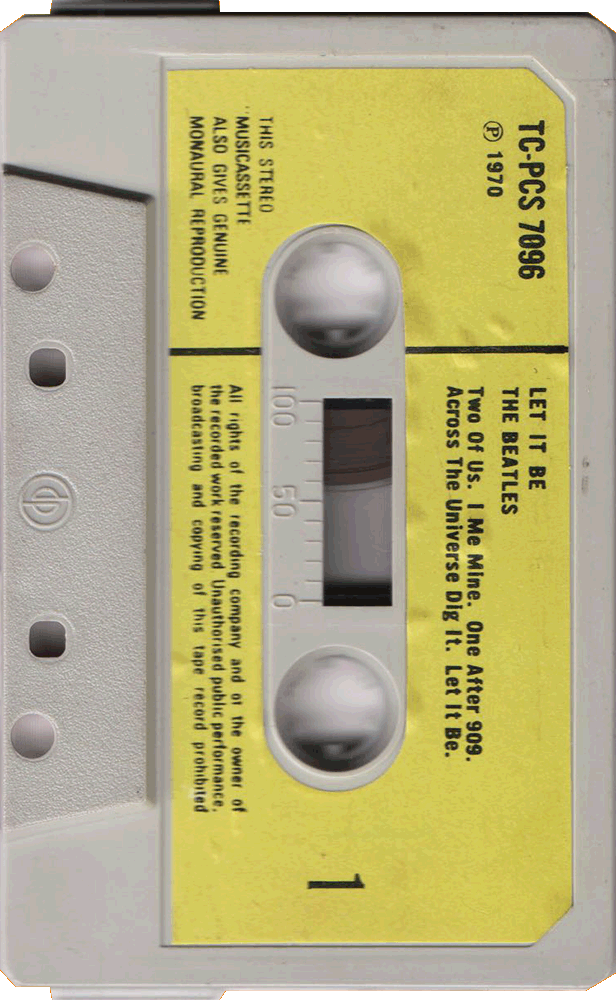 |
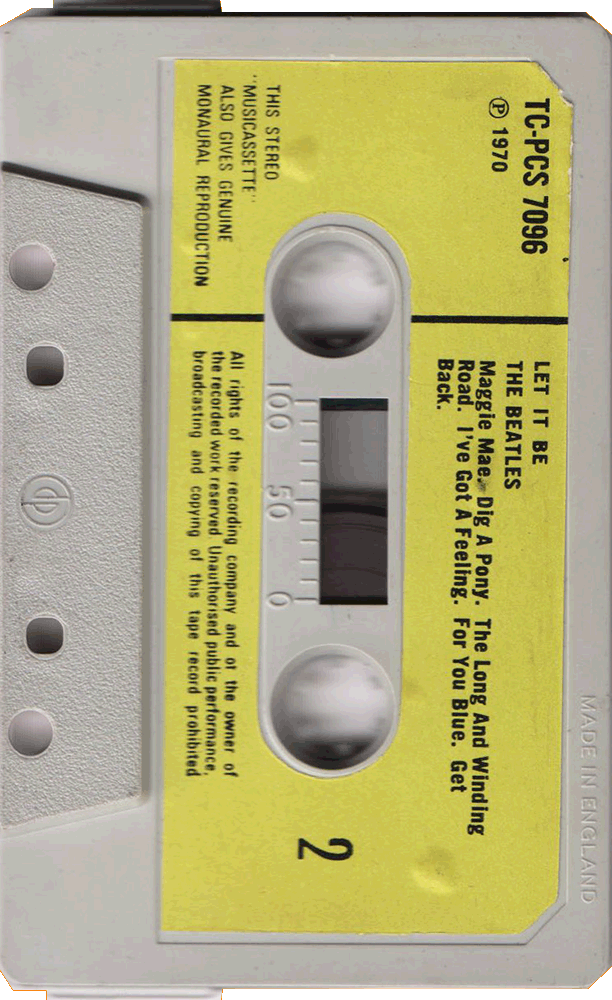 |
|
| The cassette cases ("Norelco" cases)
were clear plastic at the front and around the spine area,
and black plastic at the rear. |
This UK issue of "Let It Be" has Lemon Yellow paper label
with Parlophone logo |
|||
| INLAY |
INLAY: FRONT | INLAY: INSIDE |
||
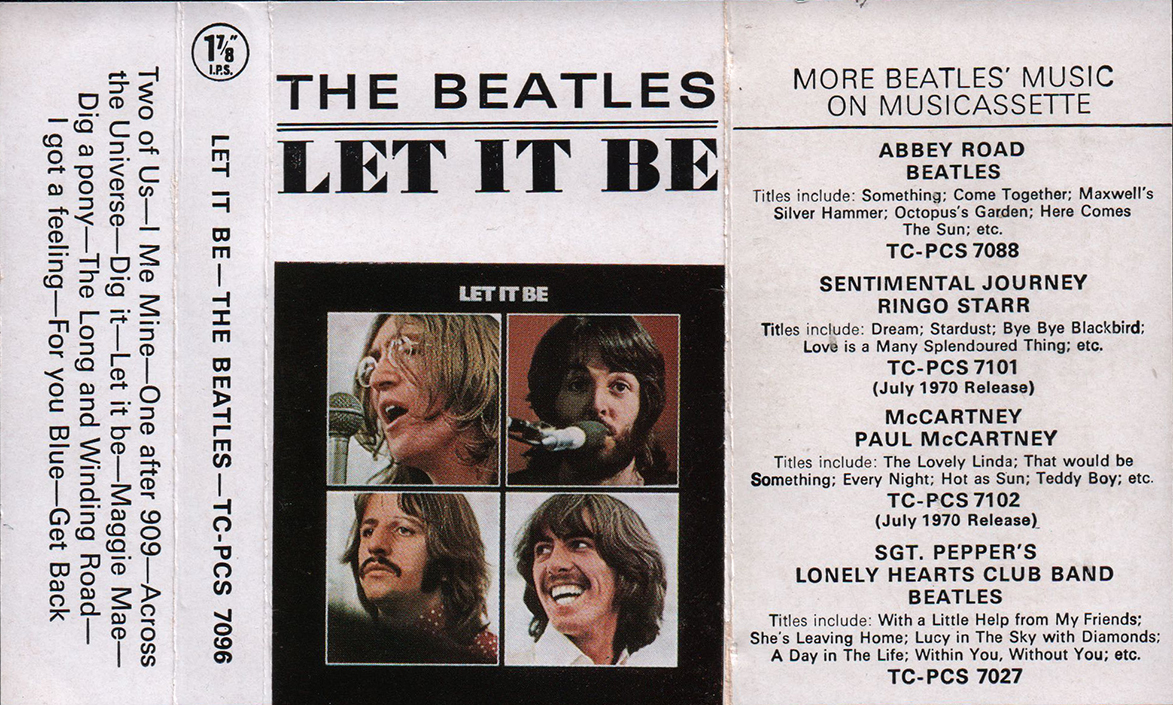 |
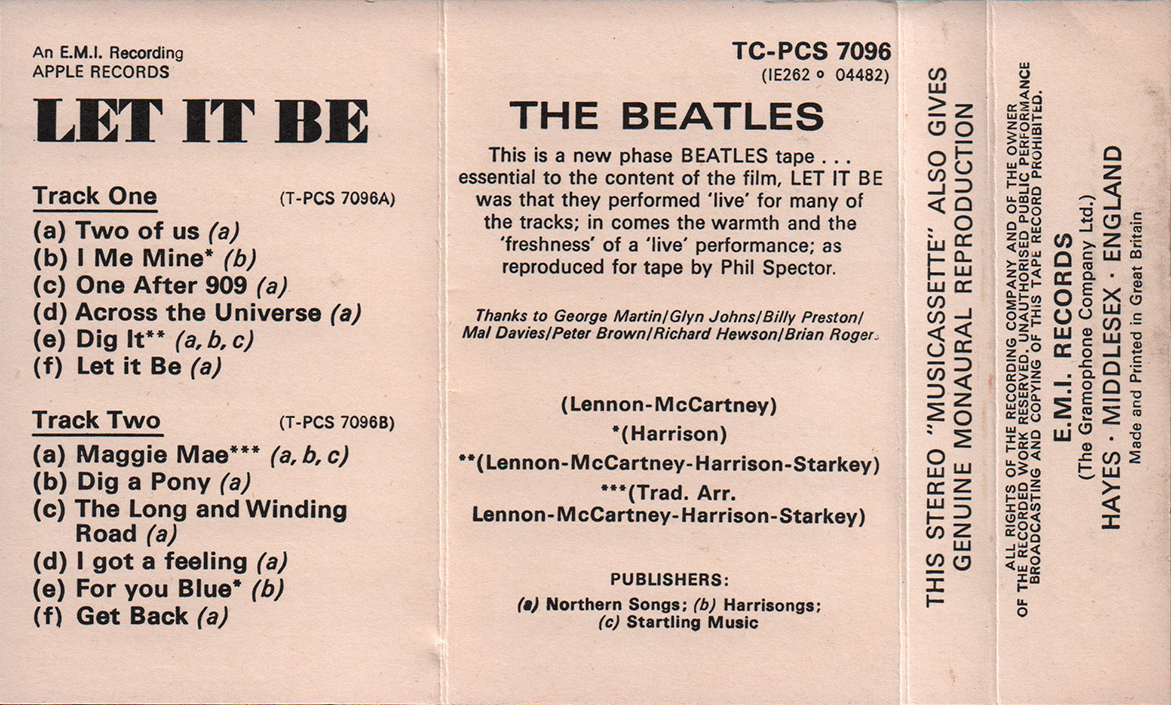 |
|||
| The 1970/71 cassettes had white inlays
and, aside from the small reproduction of the front cover,
no artwork was included nor the original liner notes. The
tracklistings were printed on the reverse of the inlay
whilst the foldovers advertised other available Beatles/solo
cassettes. |
||||
| INLAY: FRONT CLOSE UP | ||||
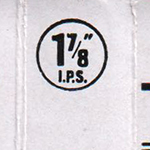 |
The
circular 1 7/8 " I.P.S. mark was printed at the spine. As the standard tape speed for a compact cassette is 1 ⅞ ips (1.875 inches per second). |
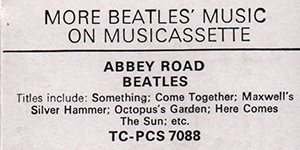 |
The tracklistings were
printed on the reverse of the inlay whilst the foldovers
advertised other available Beatles cassettes. |
|
| INLAY: FRONT CLOSE UP | ||||
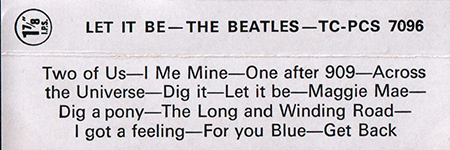 |
EMI
originally issued the Beatles UK albums on cassette tape
with re-arranged running orders, the reason for this was
that because of the 8-track stereo tapes made at the same
time, it was necessary to adjust the endless tape's four
tracks to be approximately the same length. Inlay incorrectly spells track 4 on side-2 as "I got a feeling". |
|||
| INLAY: INSIDE CLOSE UP | ||||
 |
"Apple Records" credit was added
on the inlay again (maybe). |
 |
Catalog number "TC-PCS 7096" and the EMI country code (*1) were printed on the inlay. | |
| INLAY: INSIDE CLOSE UP | ||||
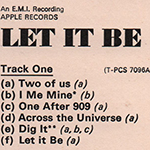 |
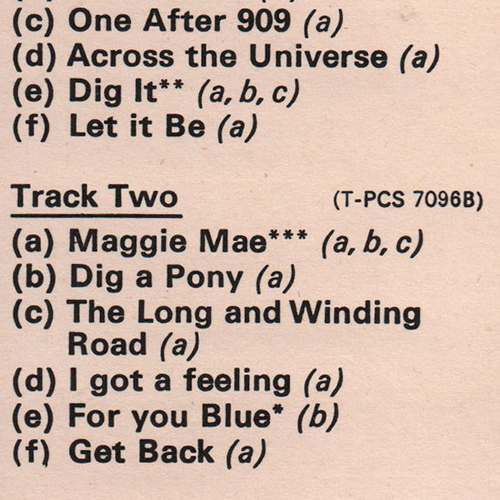 |
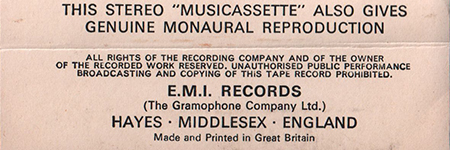 |
||
| The tracklistings were printed on the reverse of
the inlay. EMI originally issued the Beatles UK albums on
cassette tape with re-arranged running orders. |
"E.M.I. Records (The Gramophone Company Ltd.)" credit was printed at the bottom of the inside of the inlay. | |||
 |
 |
|||
| LABEL CLOSE UP | ||||
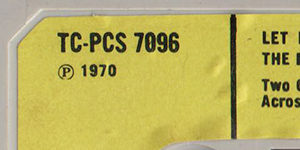 |
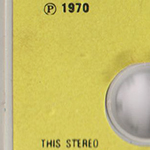 |
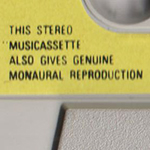 |
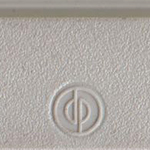 |
|
| The cassette shell labels during this 1970/1971 "white inlay" period were NO logo on the label. | Containing content as a
prerecorded cassette is called "Musicassette" |
The "DP(*2)" logo can often be found moulded into cassette shells, especially during the early to mid 1970s. | ||
| LABEL CLOSE UP | ||||
| SIDE
1 |
SIDE 2 |
On
side-2 of the label, with the NEW track listing layout
(3 lines) again instead of the lemon yellow label
type-1. |
||
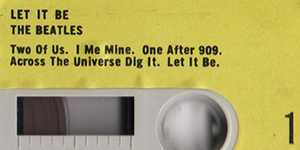 |
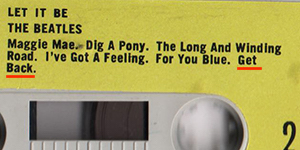 |
|||
 |
"MADE IN ENGLAND" was
embossed the shell. |
|||
| OTHER ITEM | ||||
| - |
||||
| LABEL | Lemon Yellow Paper Label without
Parlophone logo type-2 |
|||
| MIX | STEREO | |||
| RECORD COMPANY'S NAME | EMI Records (The Gramophone Company Ltd.)
/ An E.M.I. Recording * The credit "APPLE RECORDS" was added on the inlay. |
|||
| CENTRAL REMARK "SOLD IN U.K." |
- | |||
| RECORDING PUBLISHED CREDIT | (P) 1970 | |||
| INLAY FORM | "white" inlay (Foldover) |
|||
| SHELL | Light Grey Shell / embossed "MADE
IN ENGLAND" and "dp" logo mark |
|||
| CASSETTE CASE |
"Norelco"
cases:
clear
plastic
at the front and around the spine area, and black plastic at
the rear. |
|||
| PRINTER CREDIT | Made and Printed in Great Britain |
|||
| COVER DESIGN/ PHOTO/ NOTES | Design: by John Kosh Photographs: Ethan Russell |
|||
| PRODUCER | Reproduced for tape by Phil Spector | |||
| COMMENTS | The original Beatles cassette
release of "Sgt. Peppers" in 1968, through "Abbey Road
(1969)", "Let It Be (August 1970)", and the first release of
most of the other Beatles cassette albums in September and
October, 1970, just months after EMI opened their new tape
duplicating facilities at Hayes in Middlesex in July, 1970. Prior to the opening of their own plant, EMI's cassette tapes were manufactured for them by the Dutch firm, Phillips, who themselves had pioneered the concept of the musicassette format. These 1968-1972 first edition Beatles cassettes were manufactured in small numbers, and in an "experimental and tentative" design to test a then unknown, but potentially large market, which was still dominated by vinyl, and as such, are scarce and rare desirable finds for collectors today. Sgt. Peppers: released October, 1967, 4 months after vinyl counterpart Abbey Road: released October/November,1969, at the same time as vinyl counterpart. Let It Be: released August,1970, 3 months after vinyl counterpart. The above are known as the "original" cassettes, and were essentially EMI's trial design of the brand new music format, to test the market for cassette tape products - a format designed for 'on the move' listening on car stereo players. Attractive though the "Sgt. Peppers" and "Abbey Road" inlay designs were, it was the "Let It Be", inlay design that became the favoured one, and provided the template for the first cassette releases of the other Beatles albums in September and October 1970. (except "Magical Mystery Tour" and "Yellow Submarine") Rubber soul, Revolver, and A Collection of Beatles Oldies were issued in September, 1970. The 1970/1971 cassettes all had white inlays and aside from the small reproduction of the vinyl album front cover, no art work was included, nor the original liner notes. The tracklistings were printed on the reverse of the inlay whilst the foldovers offered a list of other available Beatles/solo cassettes. The two exceptions to this rule were "Revolver", which had a black spine and a black top above the front cover artwork. It was only available in this form for a short period before being replaced by a standard white inlay design, although this particular version did not promote any other releases. 2nd. issues had lemon yellow label, and printed on the new style black box Pharlophone / EMI logo introduced in late 1970 (maybe). The cassette shell labels during this 1970/1971 "white inlay" period were yellow and carried the black-boxed Parlophone/EMI logo or no logo at all. On side-2 of the label, with the NEW track listing layout (3 lines) instead of the lemon yellow label type-1. The cassette cases ("Norelco" cases) were clear plastic at the front and around the spine area, and black plastic at the rear. "MADE IN ENGLAND" was embossed the shell. EMI originally issued the Beatles UK albums on cassette tape with re-arranged running orders, the reason for this was that because of the 8-track stereo tapes made at the same time, it was necessary to adjust the endless tape's four tracks to be approximately the same length. Data Packaging Corporation (who also traded as Hellerman Data Packaging Ltd) supplied cassette and 8 track shells, tape and other components to the music industry. The "DP" logo can often be found moulded into cassette shells, especially during the early to mid 1970s. (*1) EMI country code: 1E 262 o 04115 The EMI country codes (introduced on 1 June, 1969): In most cases the EMI Codes are the first two letters of the record's catalog#. These EMI Country Codes were used to indicate the country in which the record was pressed. Note this doesn't necessarily means the record was also released in that country (from Discog). OC / 0C / 1E= UK |
|||
|
TITLE
|
LET IT BE |
|||
| CATALOG NUMBER | TC-PCS 7096 / 1E 262 o 04482 |
|||
|
RELEASE DATE
|
late 1971? / 6th. Issue? | |||
| TRACK LISTING | SIDE 1 | SIDE 2 | ||
| Two Of Us [A1] |
Maggie Mae [A7] |
|||
| I Me Mine [A4] | Dig A Pony [A2] |
|||
| One After 909 [B2] |
The Long And Winding Road [B3] |
|||
| Across The Universe [A3] |
I Got A Feeling [B1] |
|||
| Dig It [A5] |
For You Blue [B4] |
|||
| Let It Be [A6] | Get Back [B5] | |||
| CASSETTE CASE AND TAPE |
CASE FRONT | CASE BACK | SIDE 1 --> Click! | SIDE 2 --> Click! |
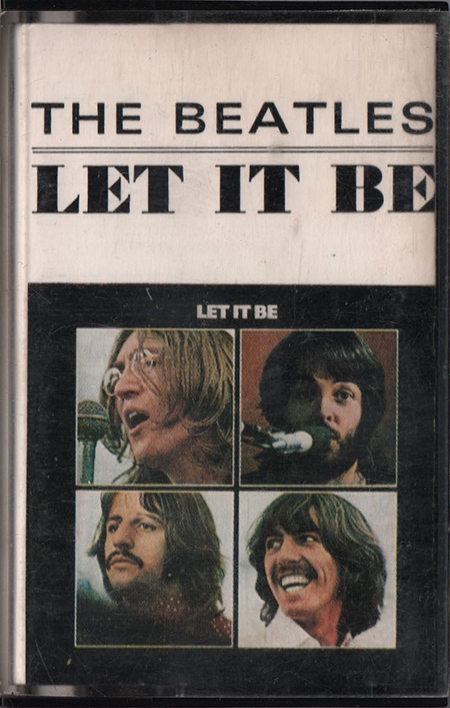 |
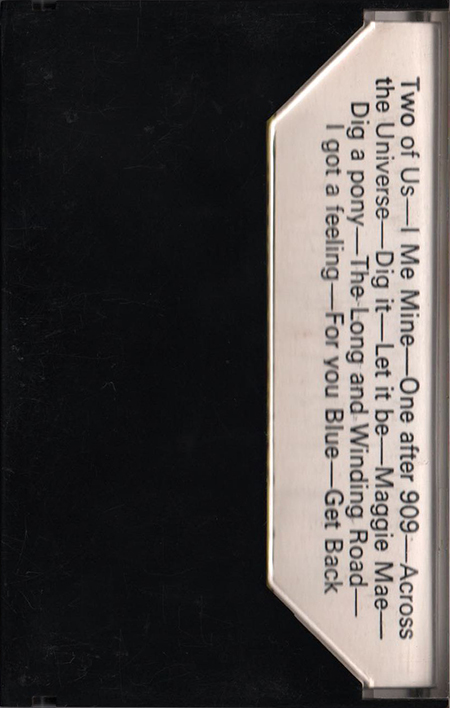 |
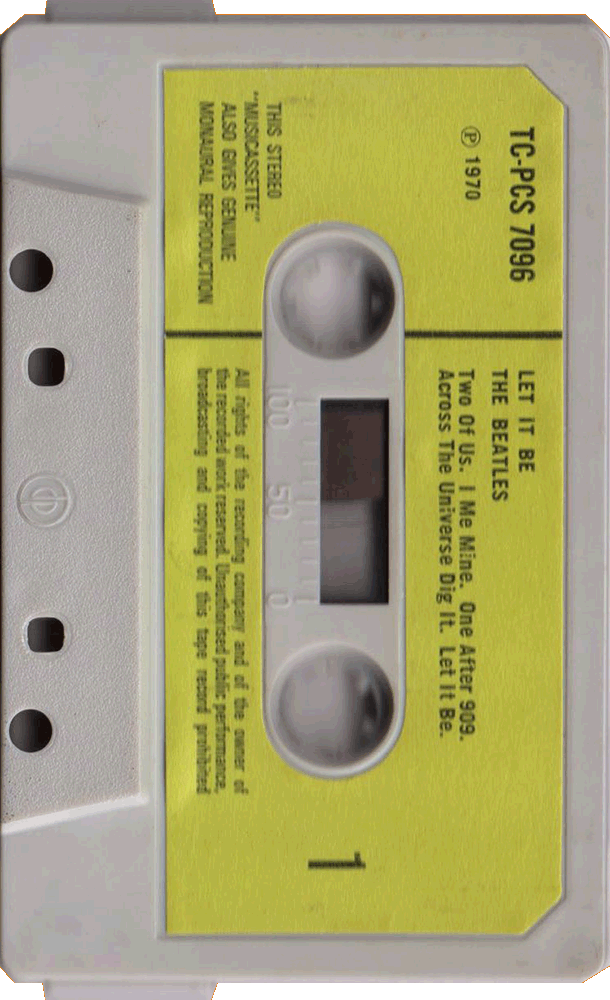 |
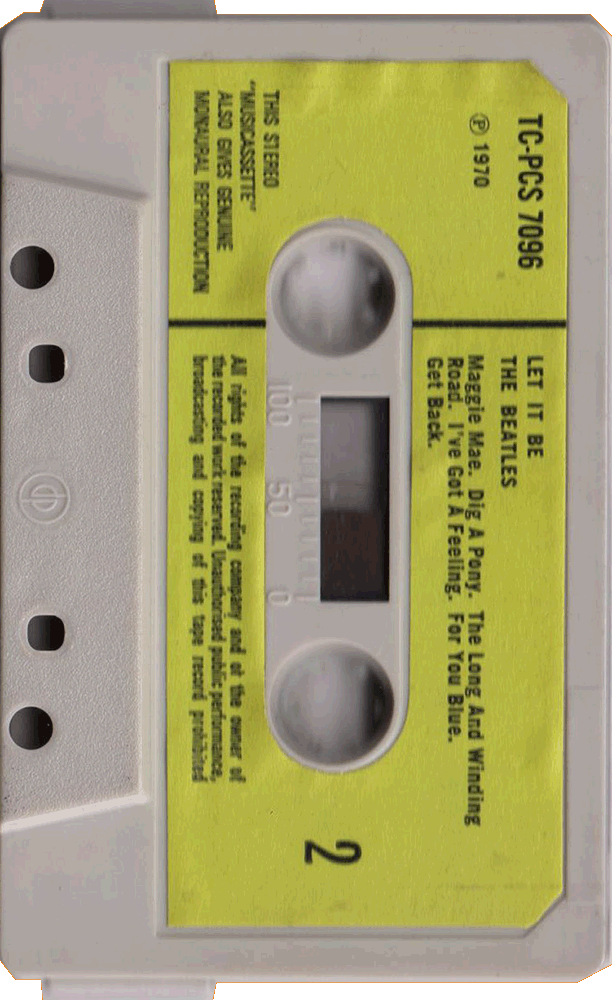 |
|
| The cassette cases ("Norelco" cases)
were clear plastic at the front and around the spine area,
and black plastic at the rear. |
This UK issue of "Let It Be" has Lemon Yellow paper label
with Parlophone logo |
|||
| INLAY |
INLAY: FRONT | INLAY: INSIDE |
||
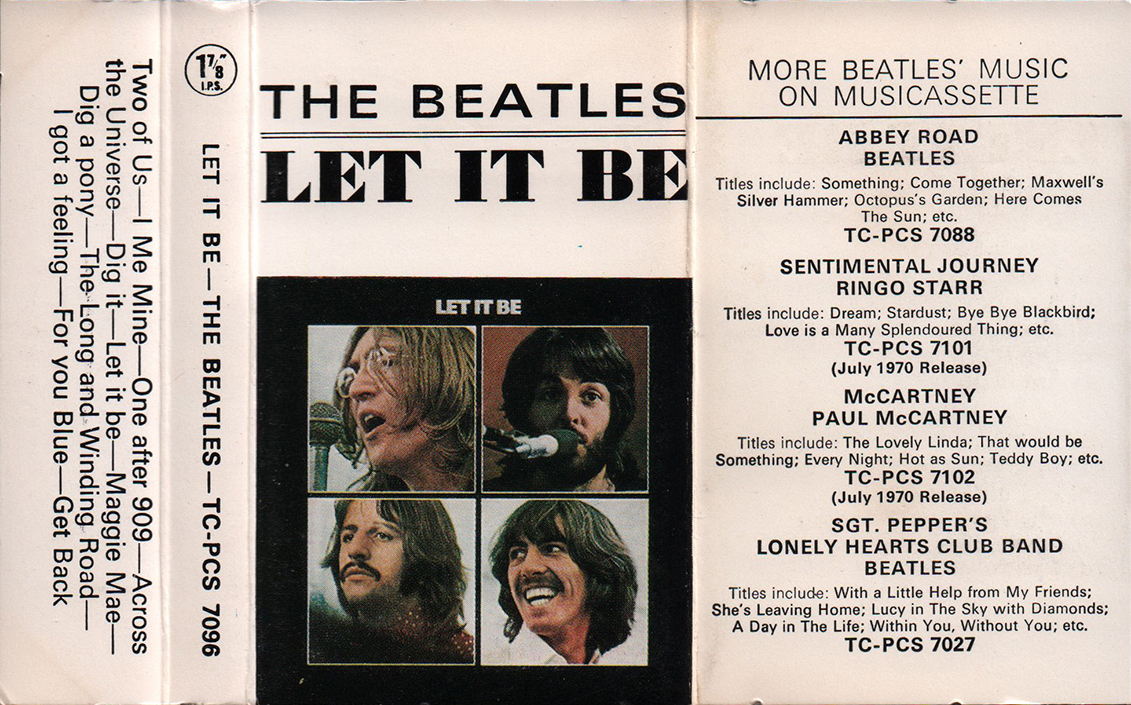 |
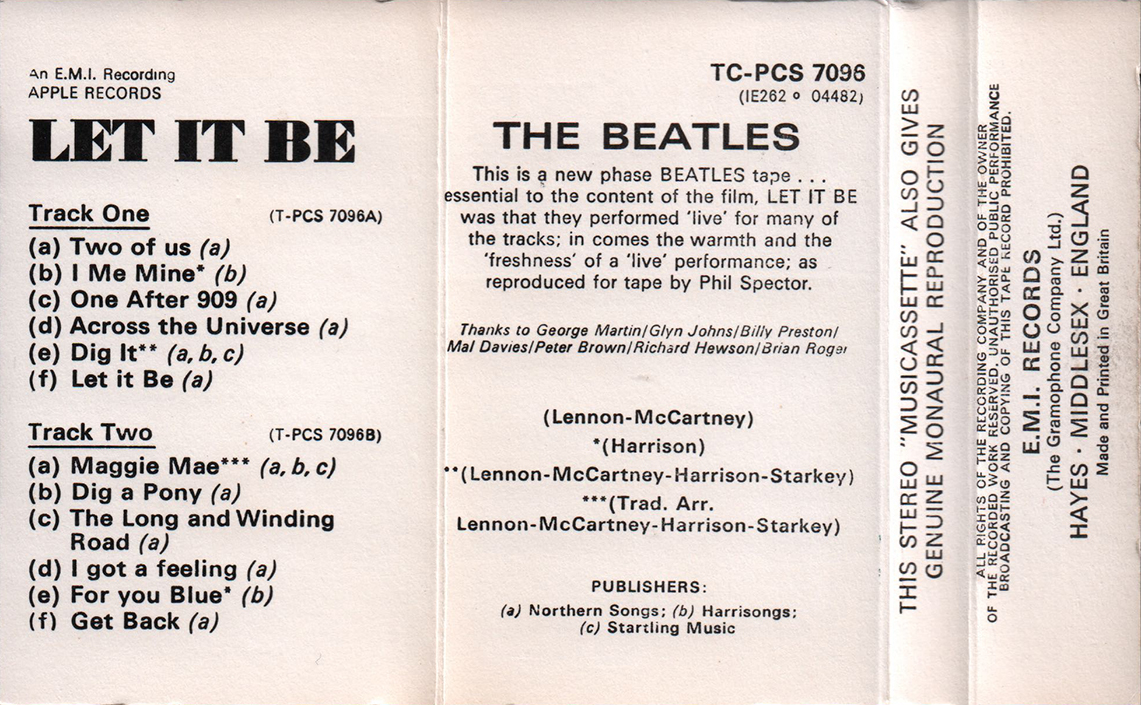 |
|||
| The 1970/71 cassettes had white inlays
and, aside from the small reproduction of the front cover,
no artwork was included nor the original liner notes. The
tracklistings were printed on the reverse of the inlay
whilst the foldovers advertised other available Beatles/solo
cassettes. |
||||
| INLAY: FRONT CLOSE UP | ||||
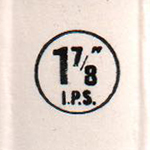 |
The
circular 1 7/8 " I.P.S. mark was printed at the spine. As the standard tape speed for a compact cassette is 1 ⅞ ips (1.875 inches per second). |
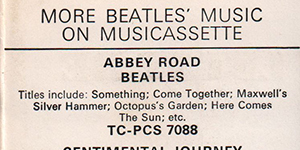 |
The tracklistings were
printed on the reverse of the inlay whilst the foldovers
advertised other available Beatles cassettes. |
|
| INLAY: FRONT CLOSE UP | ||||
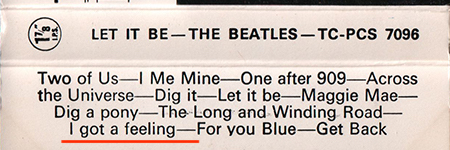 |
EMI
originally issued the Beatles UK albums on cassette tape
with re-arranged running orders, the reason for this was
that because of the 8-track stereo tapes made at the same
time, it was necessary to adjust the endless tape's four
tracks to be approximately the same length. Inlay incorrectly spells track 4 on side-2 as "I got a feeling". |
|||
| INLAY: INSIDE CLOSE UP | ||||
 |
"Apple Records" credit was added
on the inlay again (maybe). |
 |
Catalog number "TC-PCS 7096" and the EMI country code (*1) were printed on the inlay. | |
| INLAY: INSIDE CLOSE UP | ||||
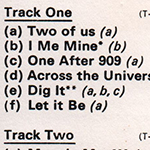 |
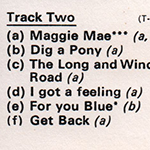 |
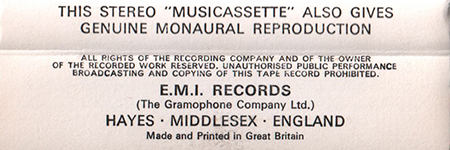 |
||
| The tracklistings were printed on the reverse of
the inlay. EMI originally issued the Beatles UK albums on
cassette tape with re-arranged running orders. |
"E.M.I. Records (The Gramophone Company Ltd.)" credit was printed at the bottom of the inside of the inlay. | |||
| LABEL CLOSE UP | ||||
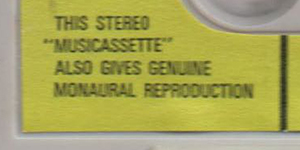 |
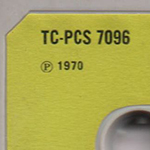 |
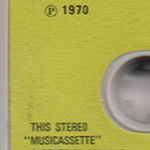 |
The cassette shell
labels during this 1970/1971 "white inlay" period were NO
logo on the label. |
|
| LABEL CLOSE UP | ||||
| SIDE
1 |
SIDE 2 |
On
side-2 of the label, with the NEW track listing layout
(3 lines) again instead of the lemon yellow label
type-1. |
||
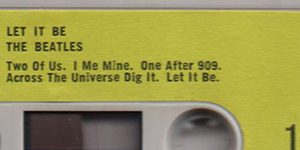 |
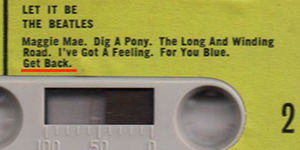 |
|||
 |
 |
The "DP(*2)" logo can often be
found moulded into cassette shells, especially during the
early to mid 1970s. "Made in England" was not embossed the shell. |
||
| OTHER ITEM | ||||
| - |
||||
| LABEL | Lemon Yellow Paper Label without
Parlophone logo type-3 |
|||
| MIX | STEREO | |||
| RECORD COMPANY'S NAME | EMI Records (The Gramophone Company Ltd.)
/ An E.M.I. Recording * The credit "APPLE RECORDS" was added on the inlay. |
|||
| CENTRAL REMARK "SOLD IN U.K." |
- | |||
| RECORDING PUBLISHED CREDIT | (P) 1970 | |||
| INLAY FORM | "white" inlay (Foldover) |
|||
| SHELL | Light Grey Shell / embossed "dp"
logo mark |
|||
| CASSETTE CASE |
"Norelco"
cases:
clear
plastic
at
the front and around the spine area, and black plastic at
the rear. |
|||
| PRINTER CREDIT | Made and Printed in Great Britain |
|||
| COVER DESIGN/ PHOTO/ NOTES | Design: by John Kosh Photographs: Ethan Russell |
|||
| PRODUCER | Reproduced for tape by Phil Spector | |||
| COMMENTS | The original Beatles cassette
release of "Sgt. Peppers" in 1968, through "Abbey Road
(1969)", "Let It Be (August 1970)", and the first release of
most of the other Beatles cassette albums in September and
October, 1970, just months after EMI opened their new tape
duplicating facilities at Hayes in Middlesex in July, 1970. Prior to the opening of their own plant, EMI's cassette tapes were manufactured for them by the Dutch firm, Phillips, who themselves had pioneered the concept of the musicassette format. These 1968-1972 first edition Beatles cassettes were manufactured in small numbers, and in an "experimental and tentative" design to test a then unknown, but potentially large market, which was still dominated by vinyl, and as such, are scarce and rare desirable finds for collectors today. Sgt. Peppers: released October, 1967, 4 months after vinyl counterpart Abbey Road: released October/November,1969, at the same time as vinyl counterpart. Let It Be: released August,1970, 3 months after vinyl counterpart. The above are known as the "original" cassettes, and were essentially EMI's trial design of the brand new music format, to test the market for cassette tape products - a format designed for 'on the move' listening on car stereo players. Attractive though the "Sgt. Peppers" and "Abbey Road" inlay designs were, it was the "Let It Be", inlay design that became the favoured one, and provided the template for the first cassette releases of the other Beatles albums in September and October 1970. (except "Magical Mystery Tour" and "Yellow Submarine") Rubber soul, Revolver, and A Collection of Beatles Oldies were issued in September, 1970. The 1970/1971 cassettes all had white inlays and aside from the small reproduction of the vinyl album front cover, no art work was included, nor the original liner notes. The tracklistings were printed on the reverse of the inlay whilst the foldovers offered a list of other available Beatles/solo cassettes. The two exceptions to this rule were "Revolver", which had a black spine and a black top above the front cover artwork. It was only available in this form for a short period before being replaced by a standard white inlay design, although this particular version did not promote any other releases. 2nd. issues had lemon yellow label, and printed on the new style black box Pharlophone / EMI logo introduced in late 1970 (maybe). The cassette shell labels during this 1970/1971 "white inlay" period were yellow and carried the black-boxed Parlophone/EMI logo or no logo at all. On side-2 of the label, with the NEW track listing layout (3 lines) instead of the lemon yellow label type-2. The cassette cases ("Norelco" cases) were clear plastic at the front and around the spine area, and black plastic at the rear. EMI originally issued the Beatles UK albums on cassette tape with re-arranged running orders, the reason for this was that because of the 8-track stereo tapes made at the same time, it was necessary to adjust the endless tape's four tracks to be approximately the same length. Data Packaging Corporation (who also traded as Hellerman Data Packaging Ltd) supplied cassette and 8 track shells, tape and other components to the music industry. The "DP" logo can often be found moulded into cassette shells, especially during the early to mid 1970s. (*1) EMI country code: 1E 262 o 04115 The EMI country codes (introduced on 1 June, 1969): In most cases the EMI Codes are the first two letters of the record's catalog#. These EMI Country Codes were used to indicate the country in which the record was pressed. Note this doesn't necessarily means the record was also released in that country (from Discog). OC / 0C / 1E= UK |
|||
